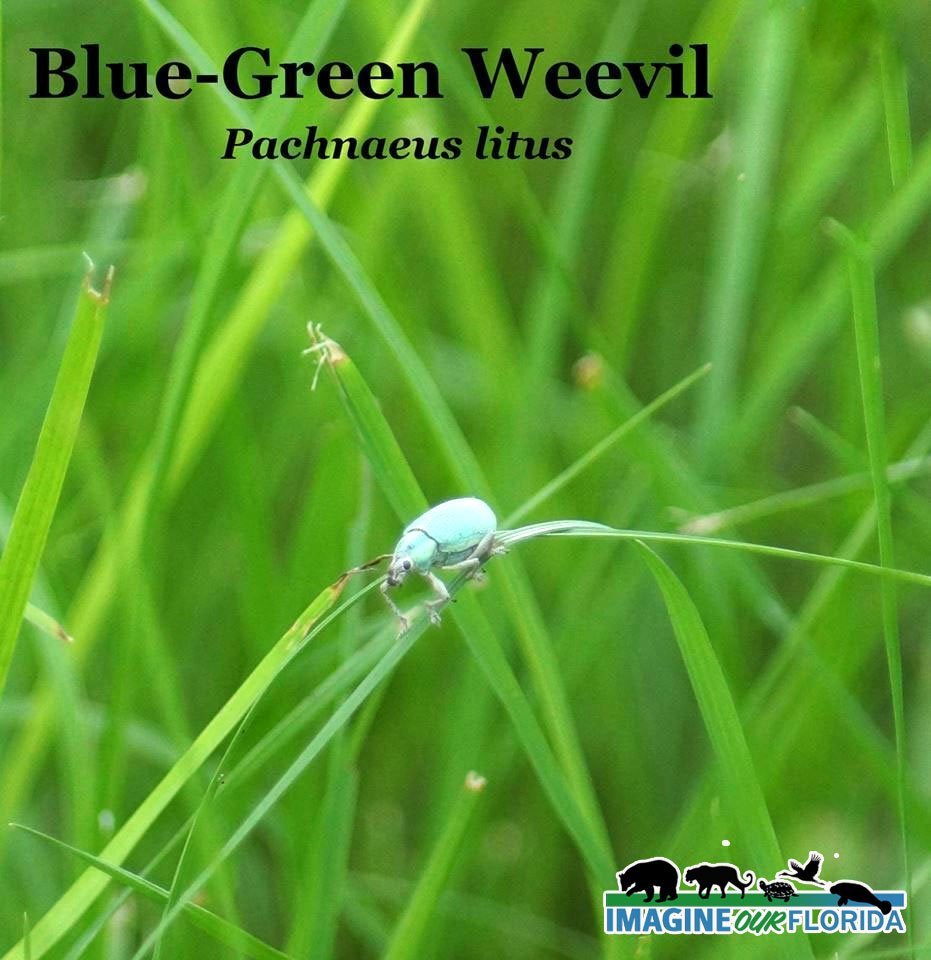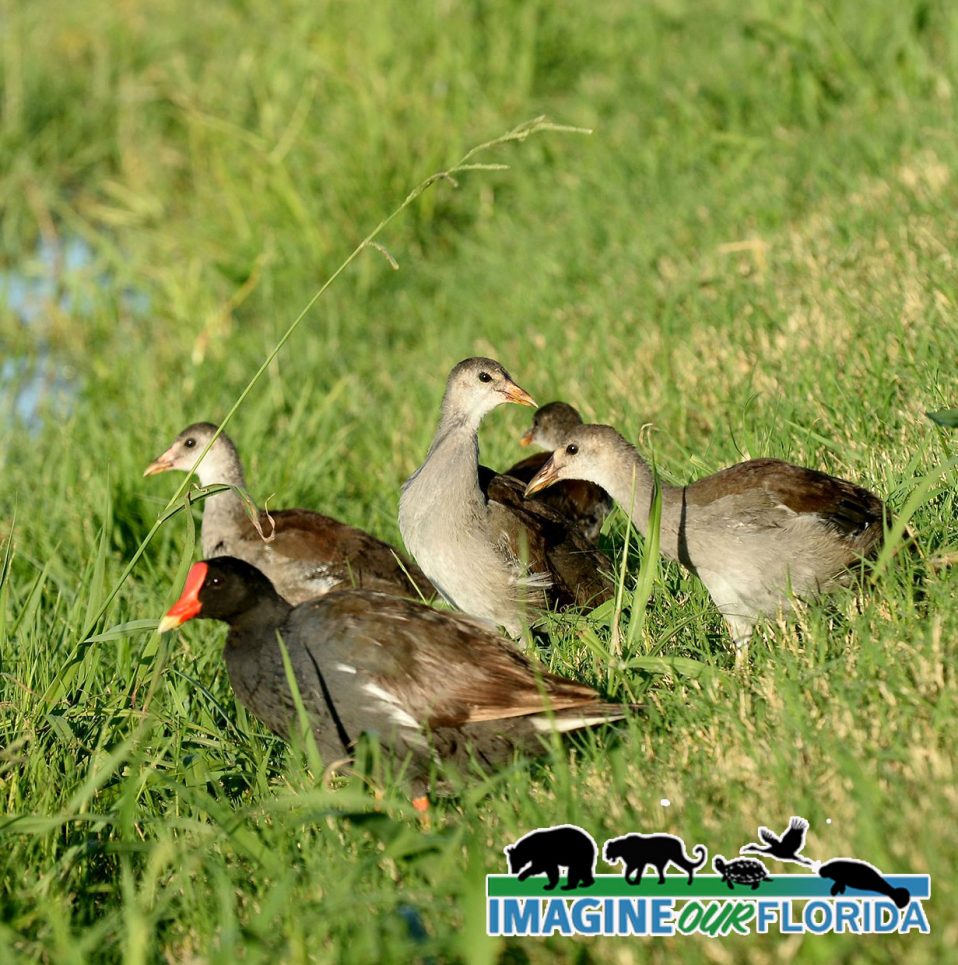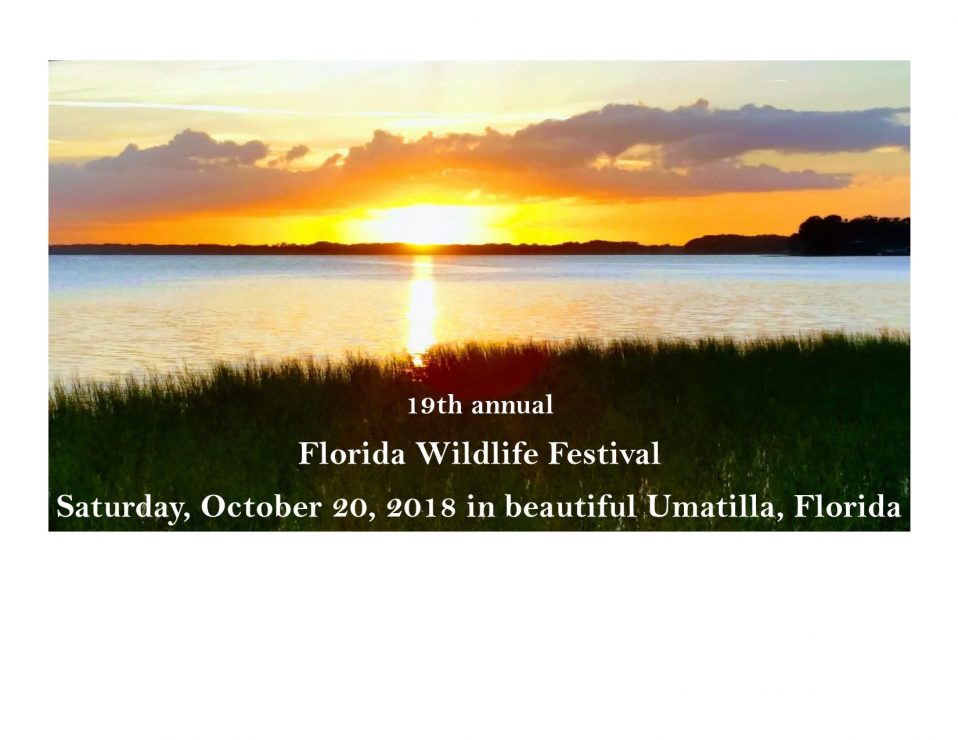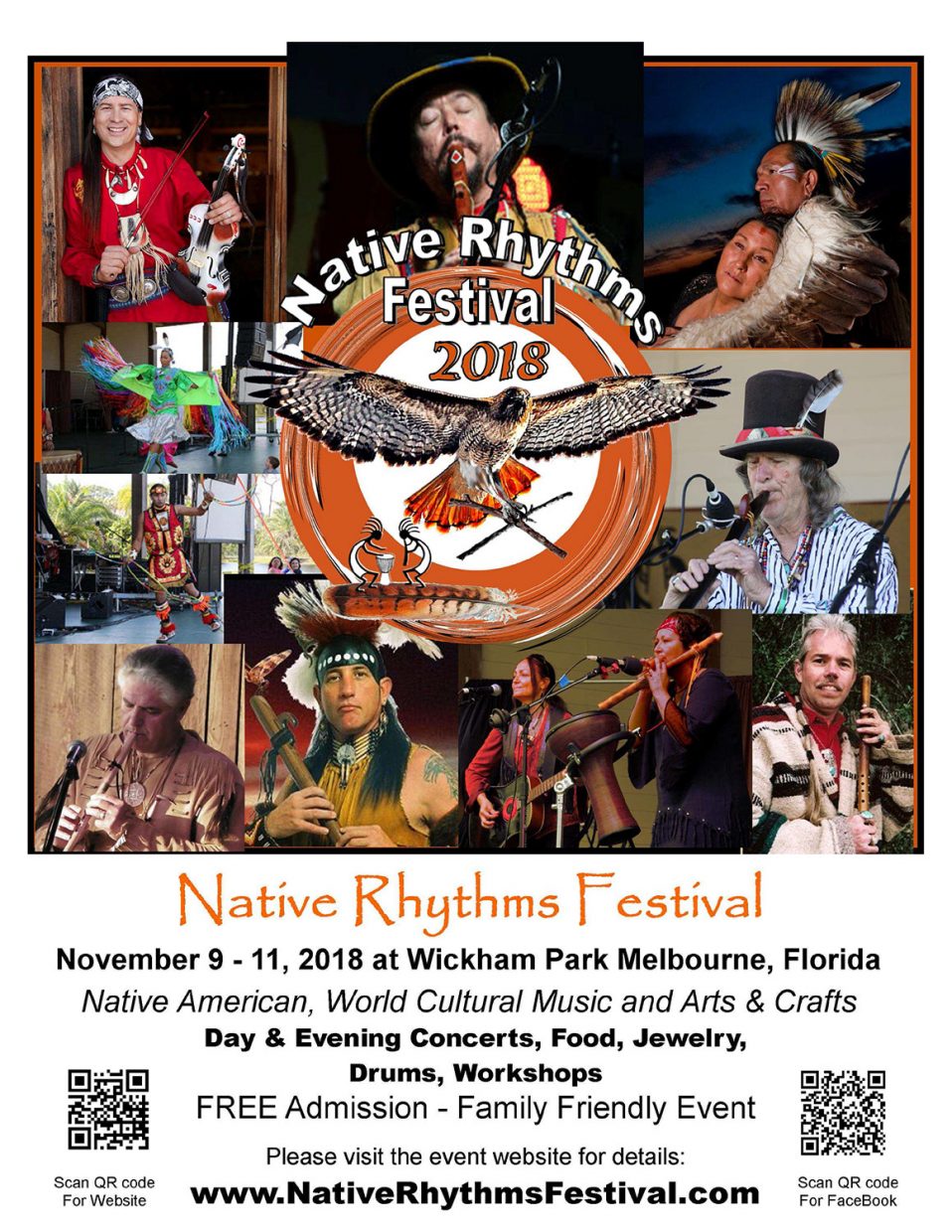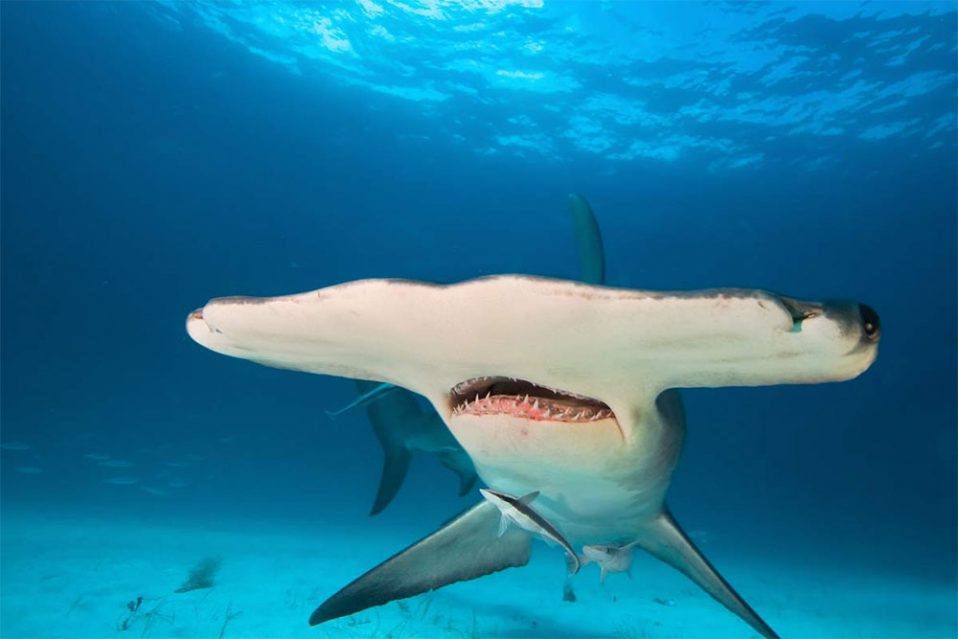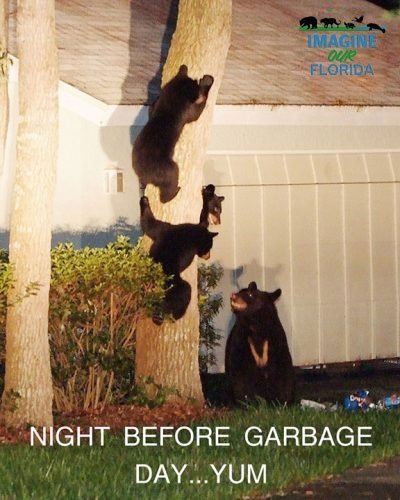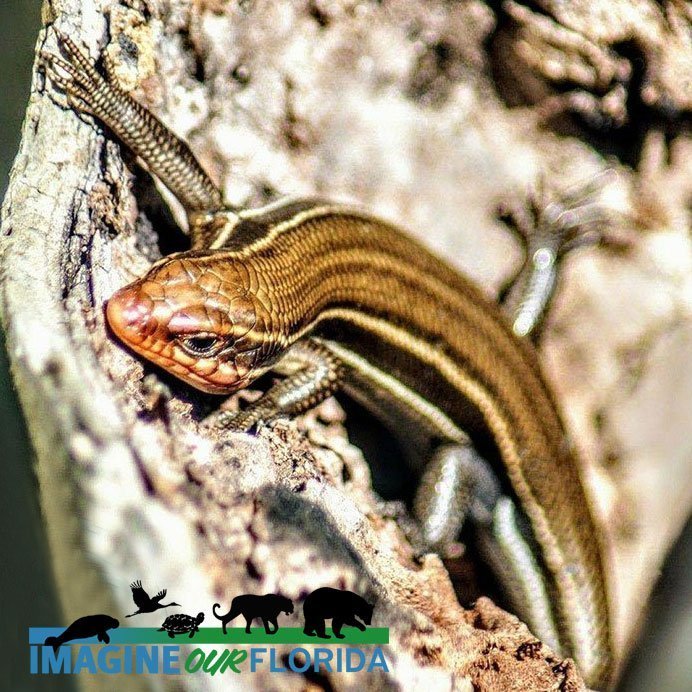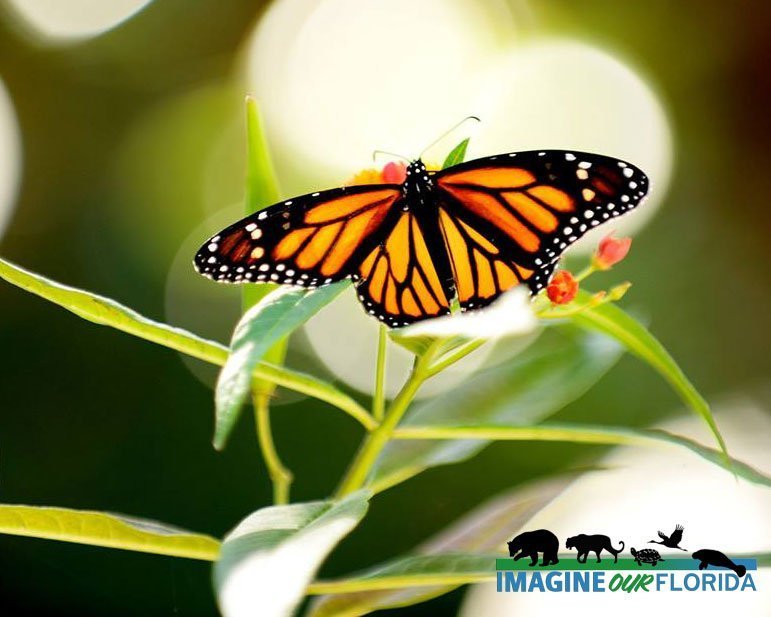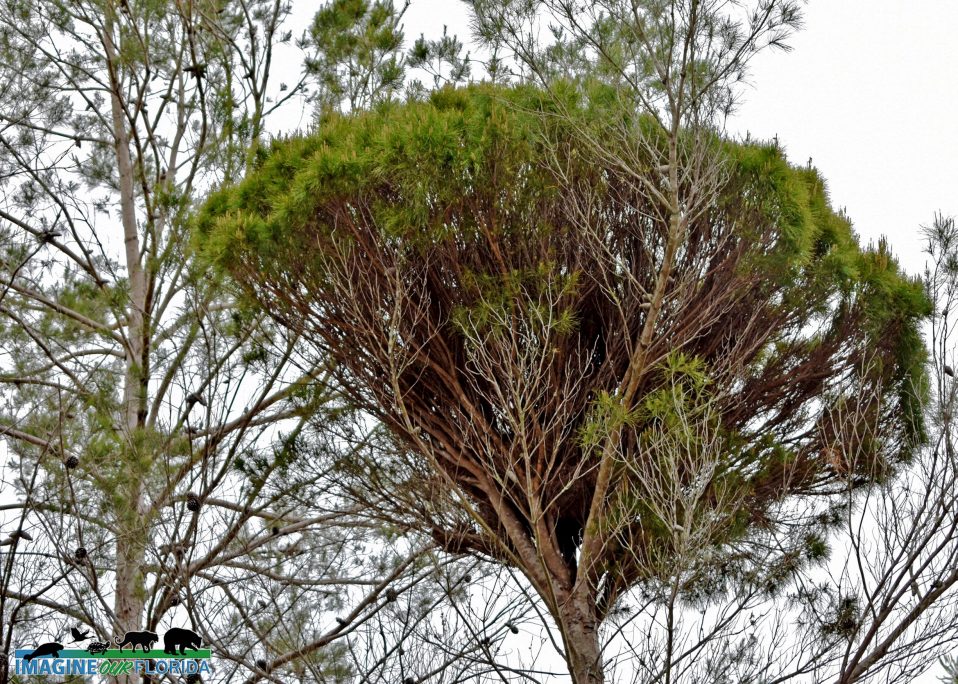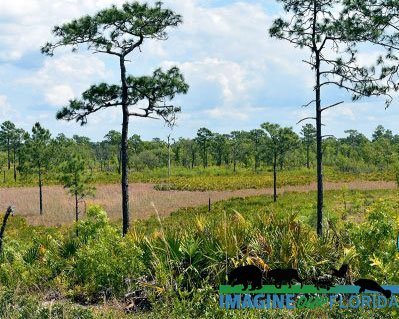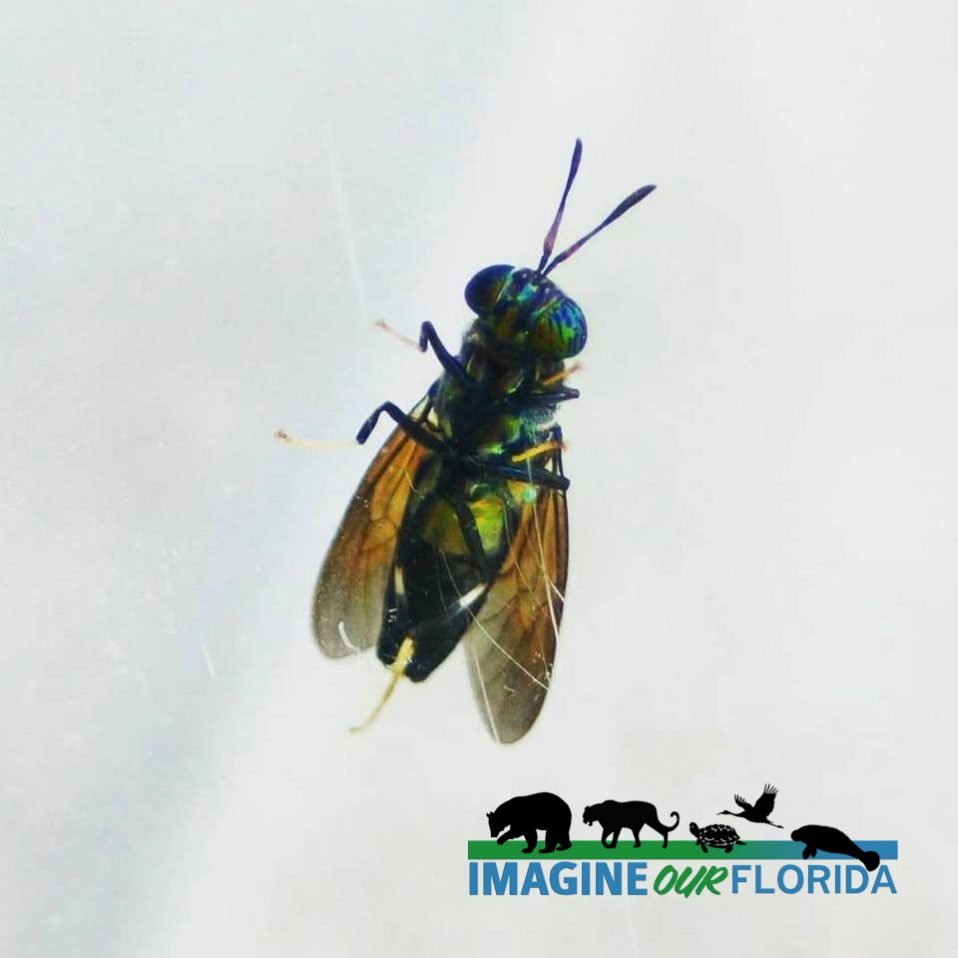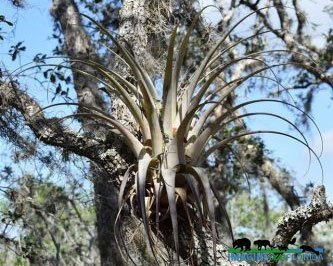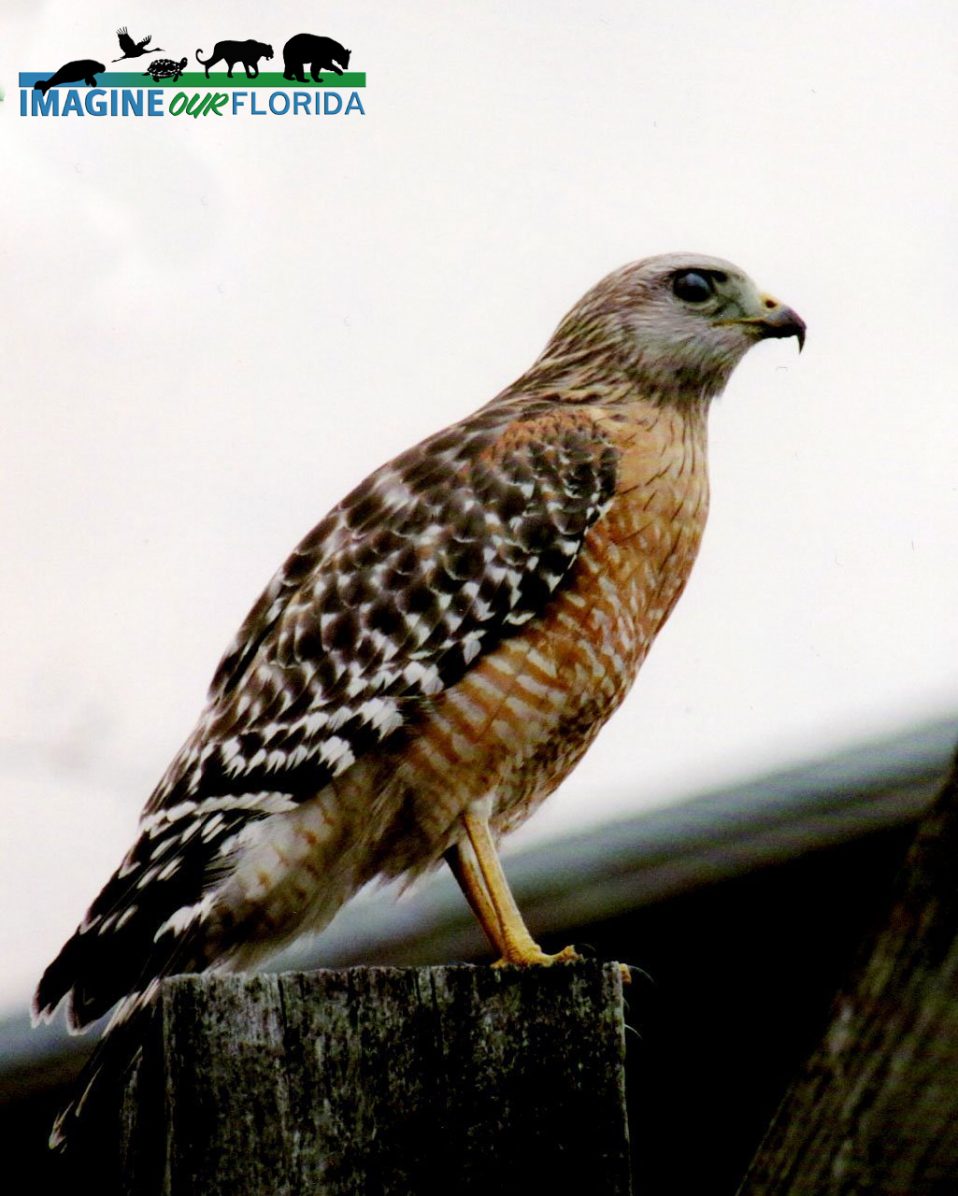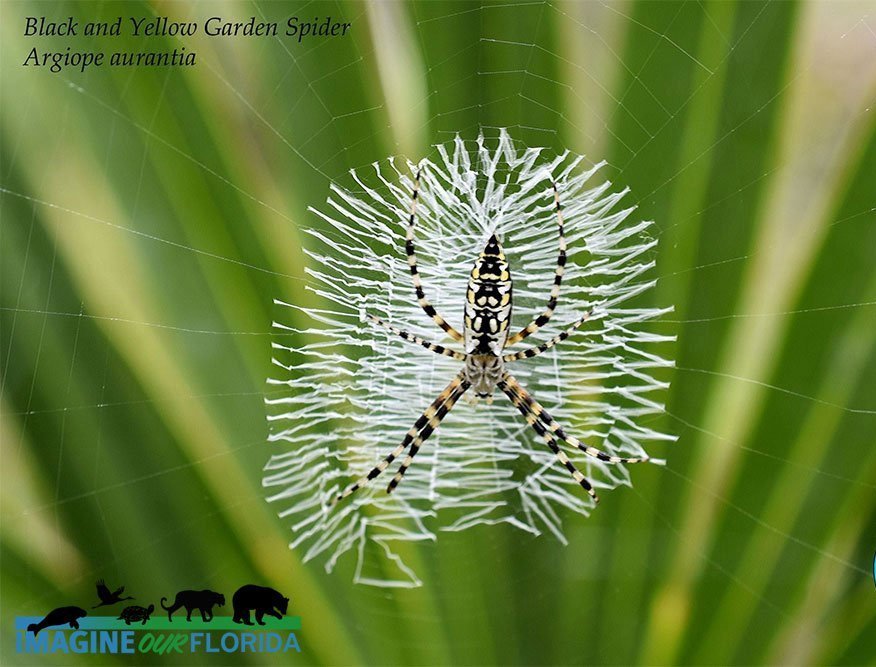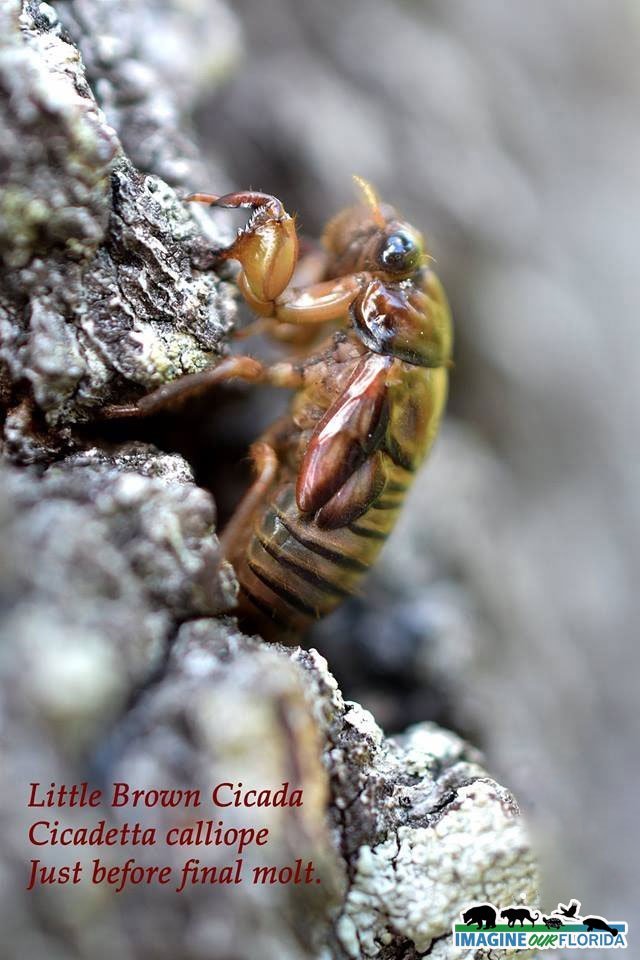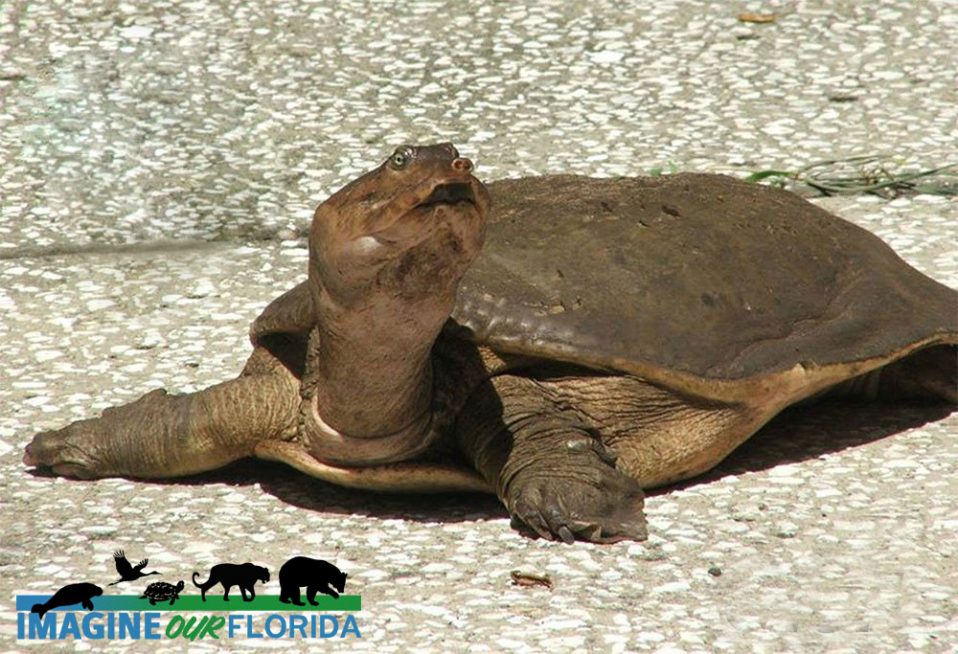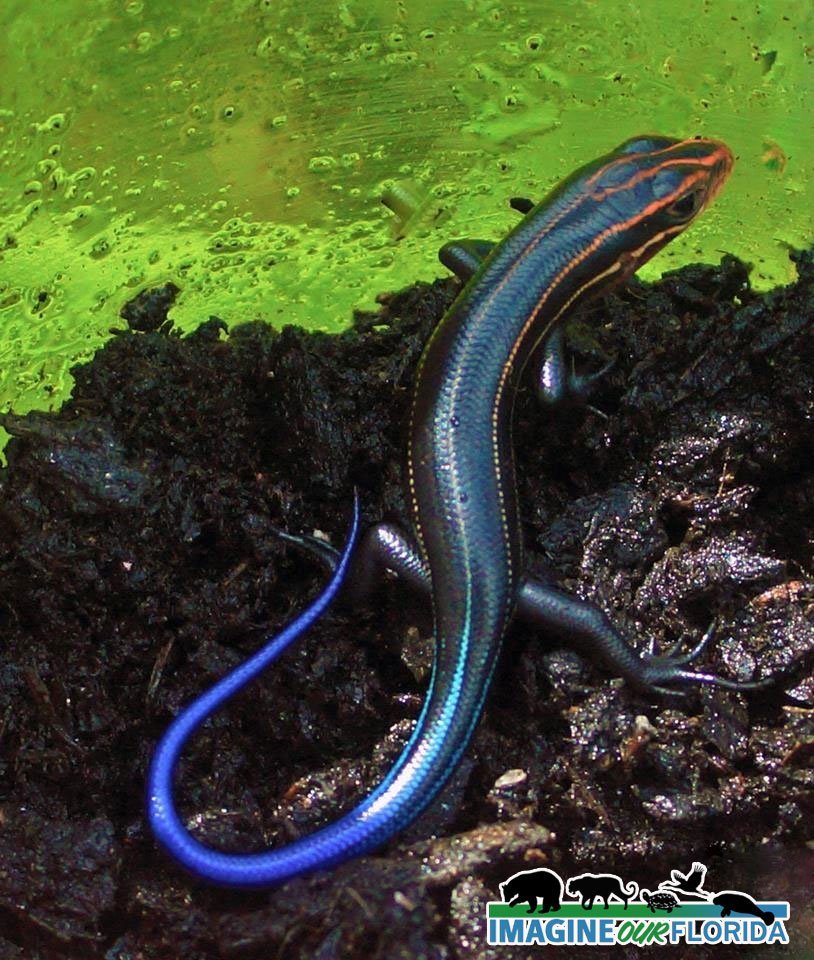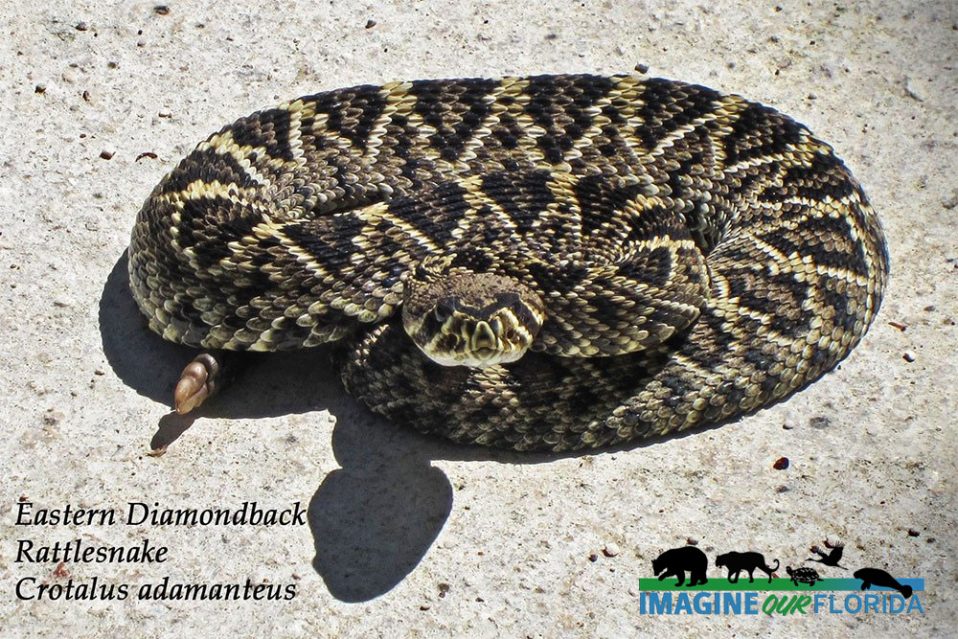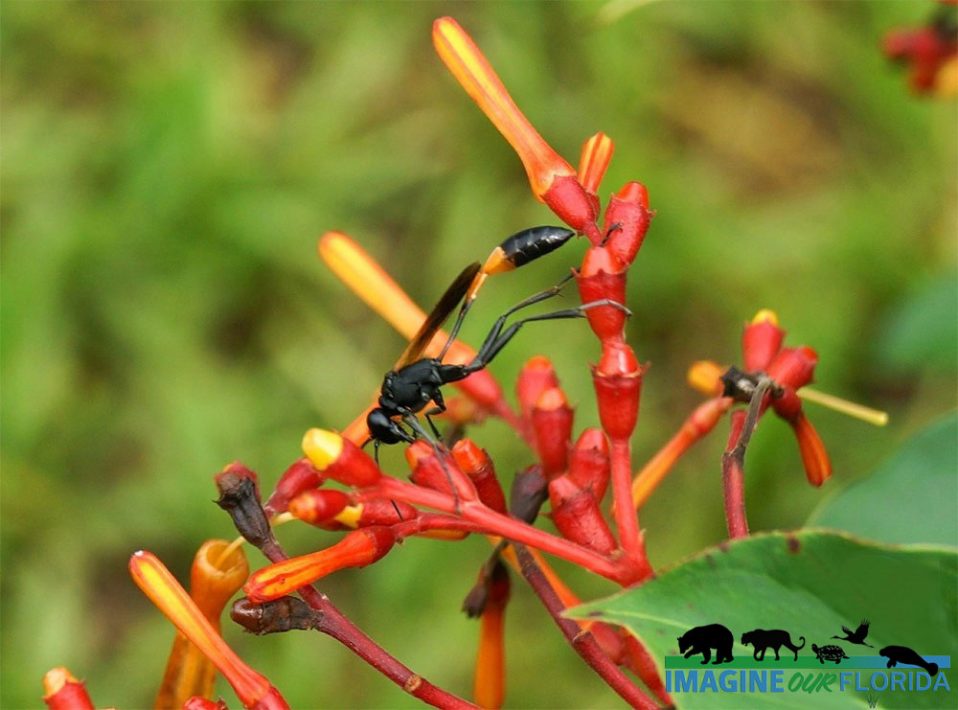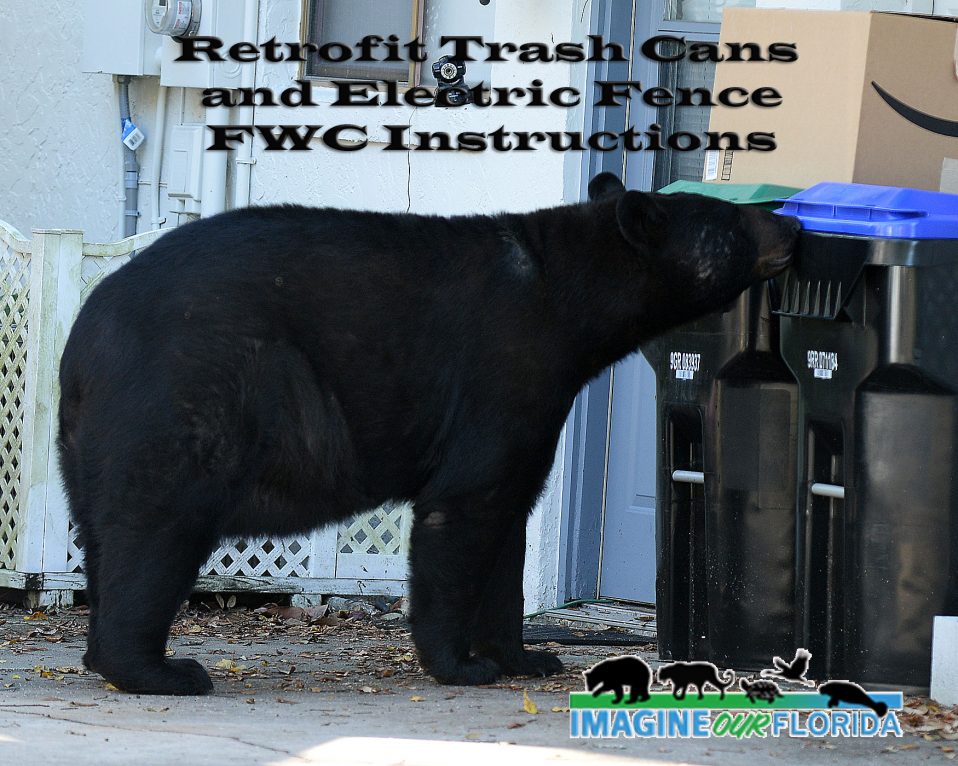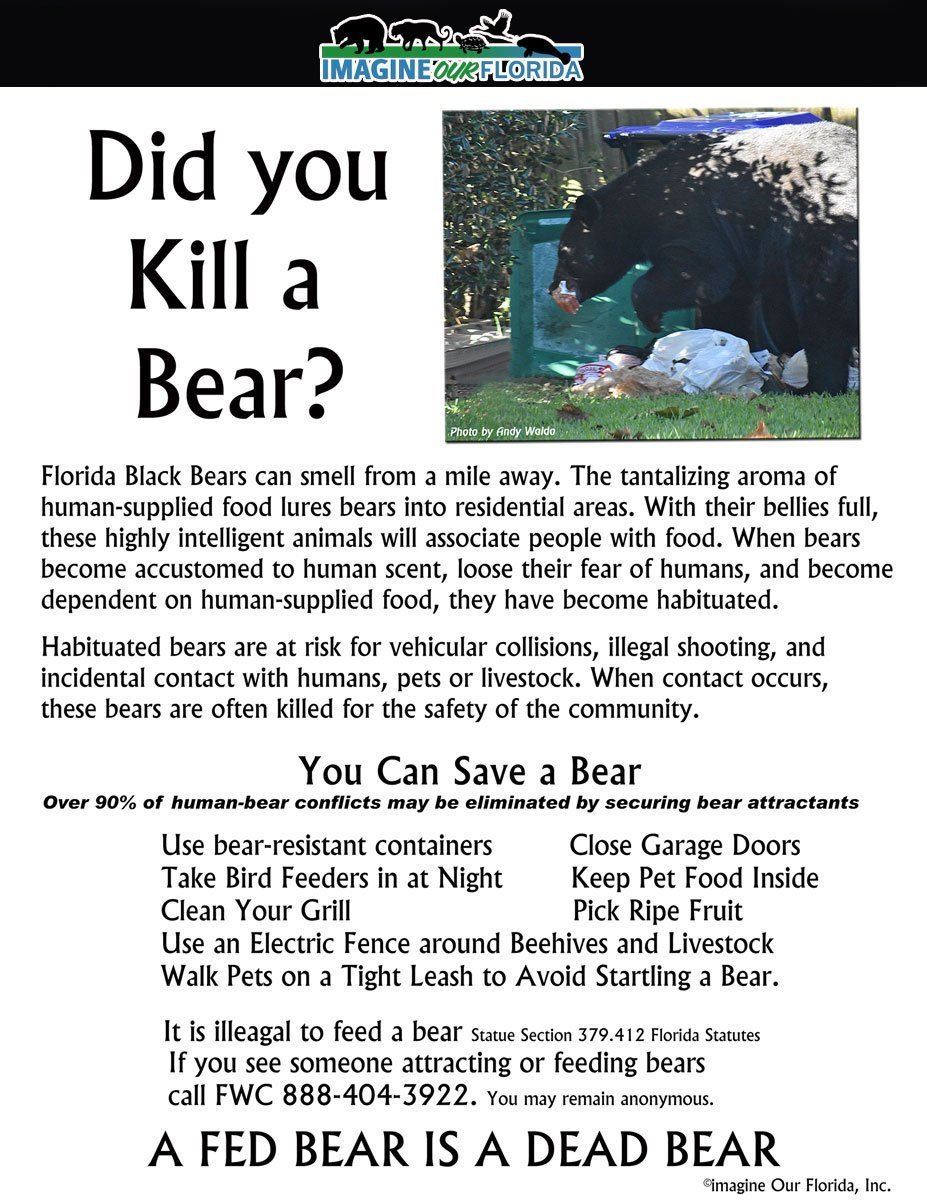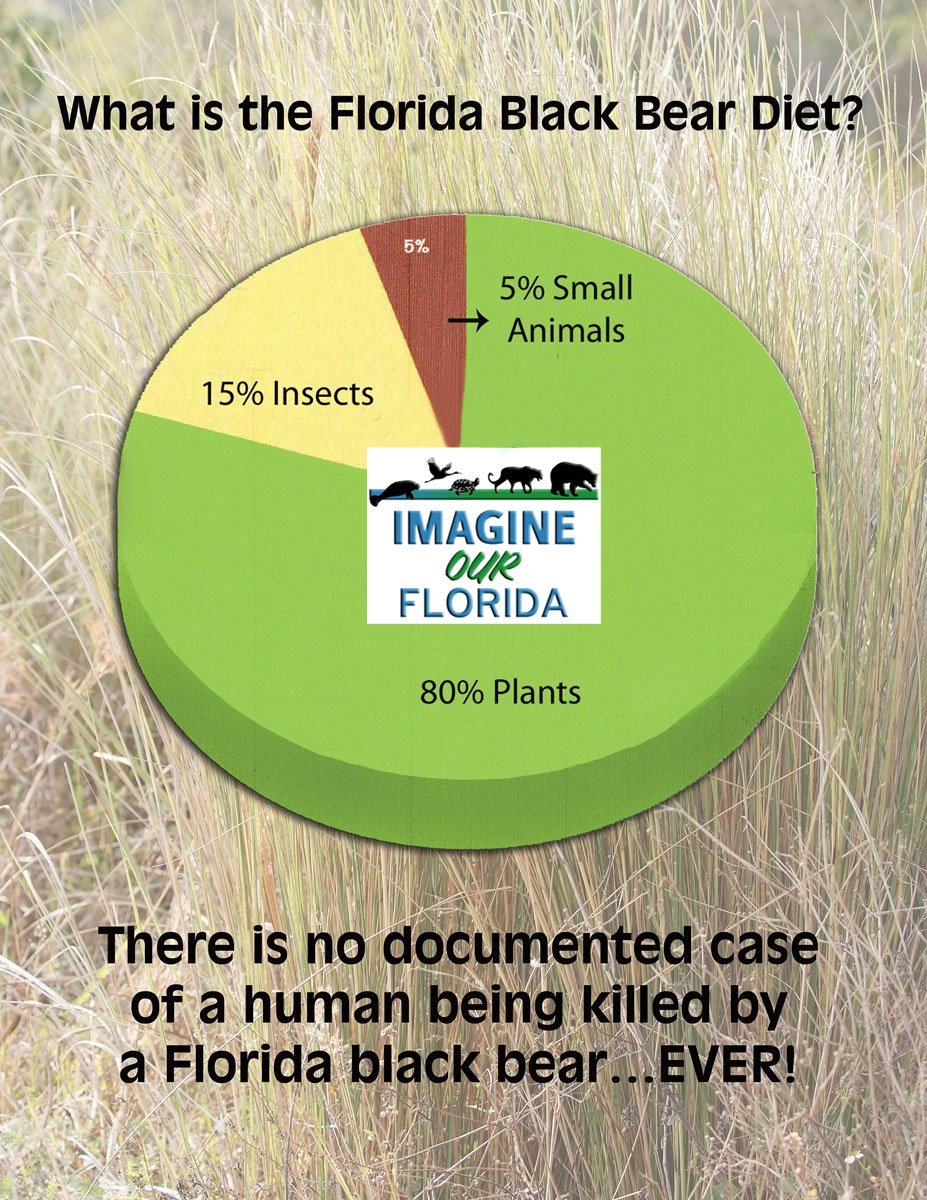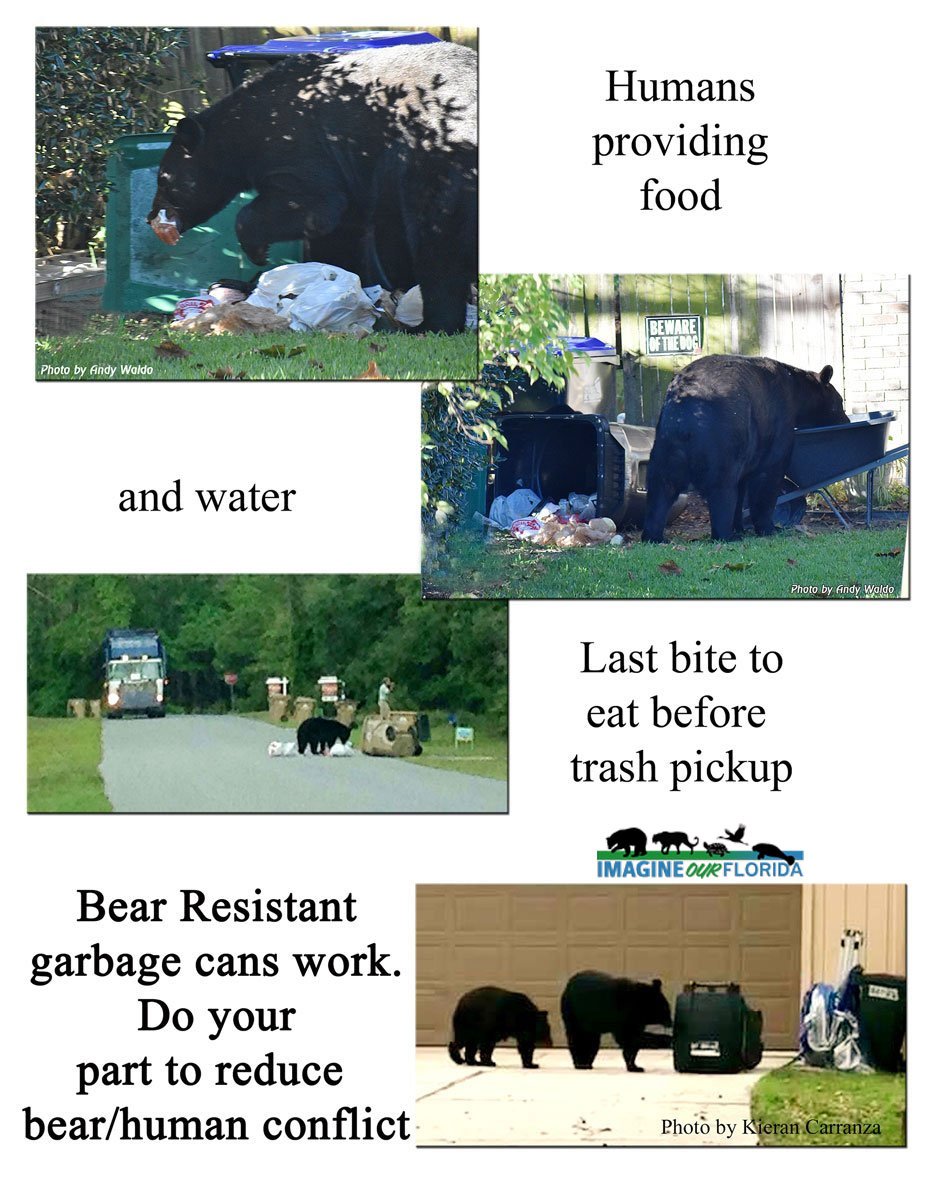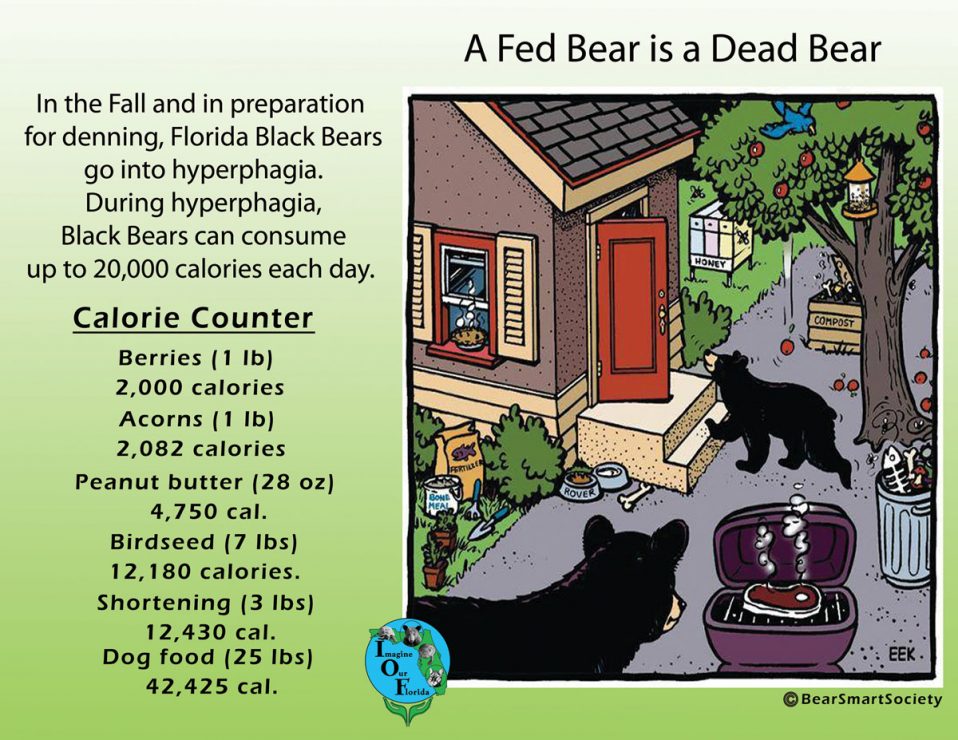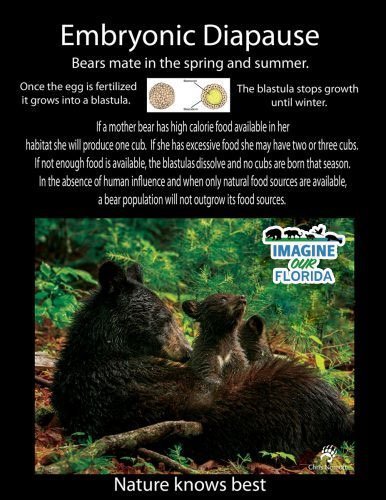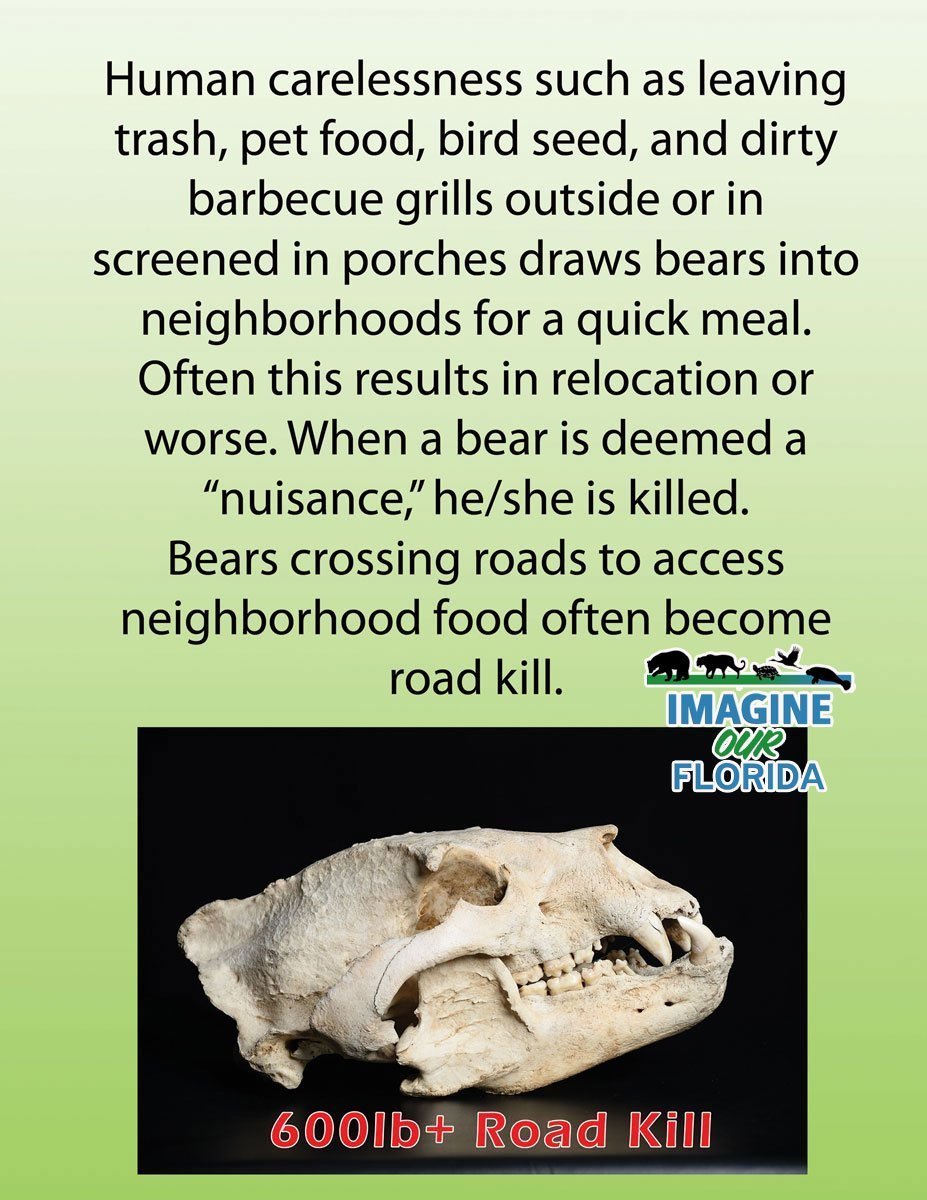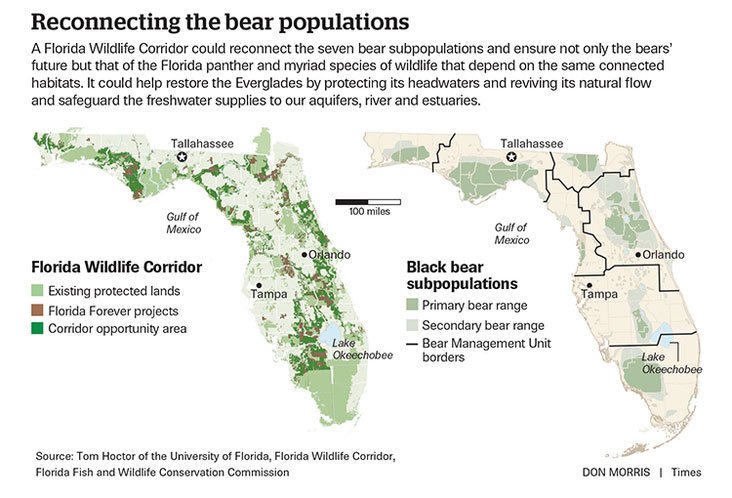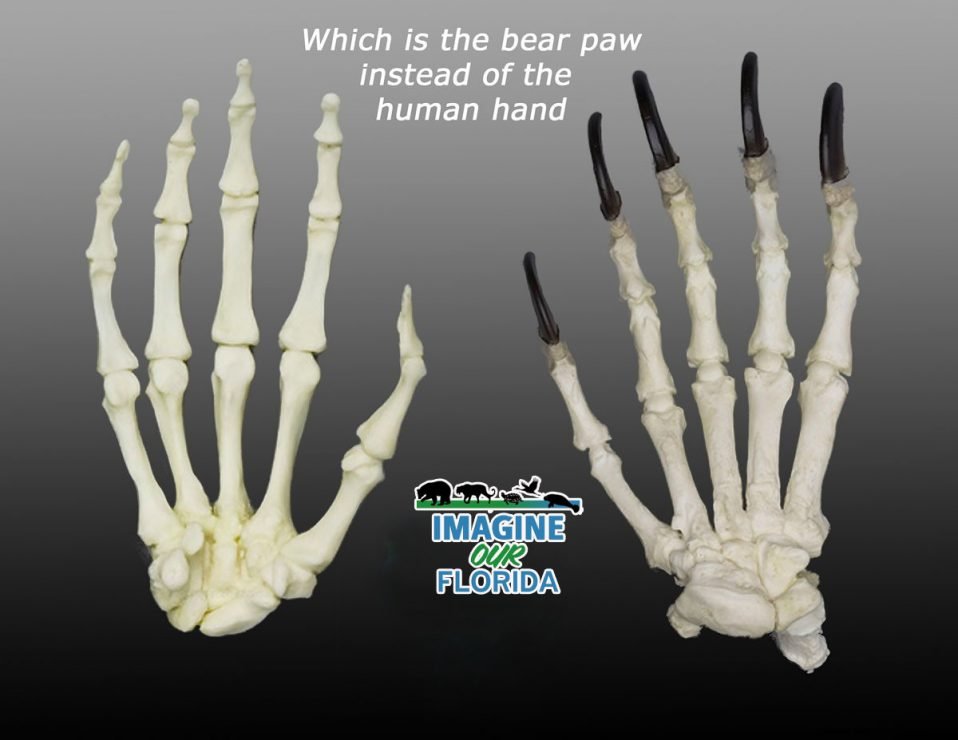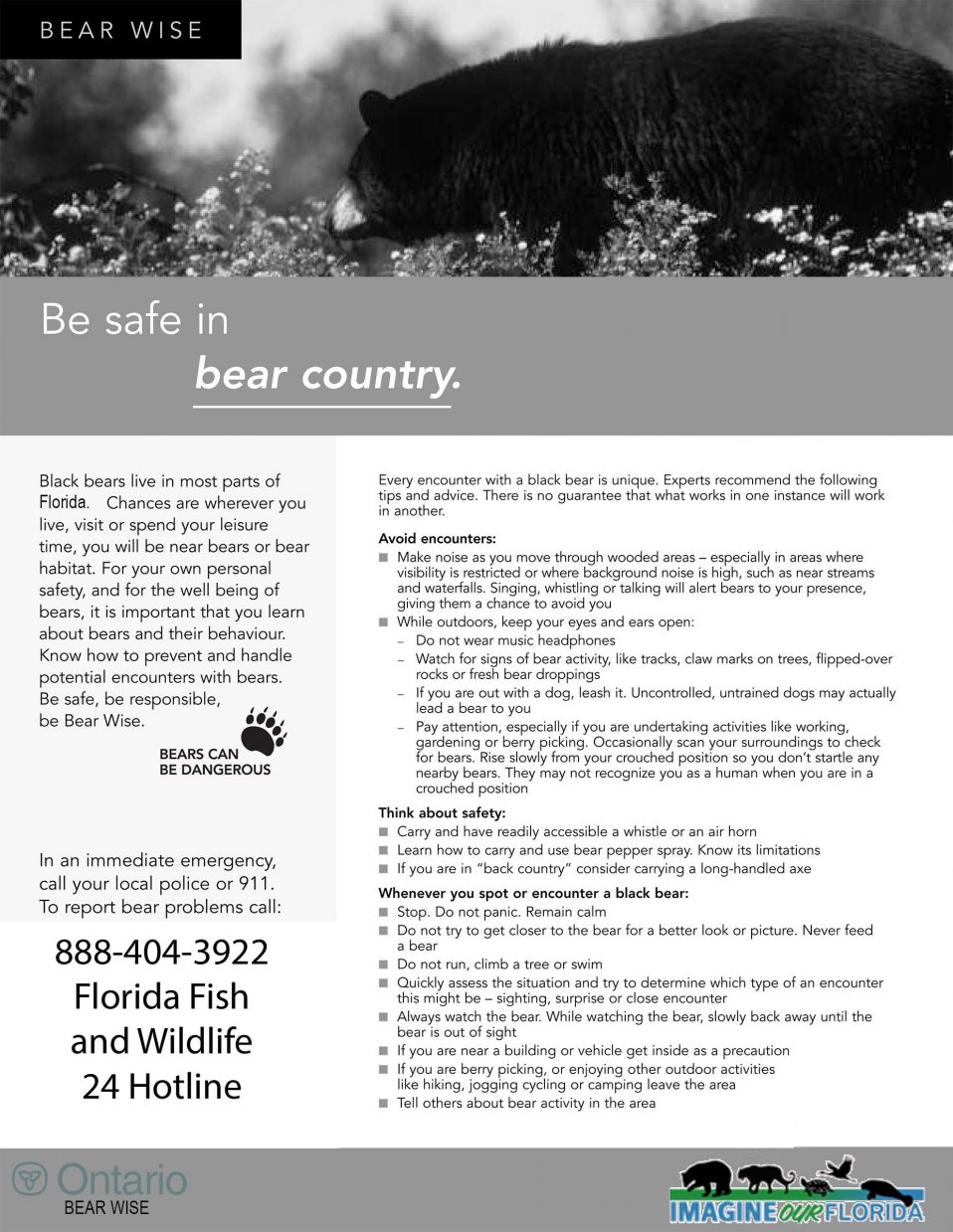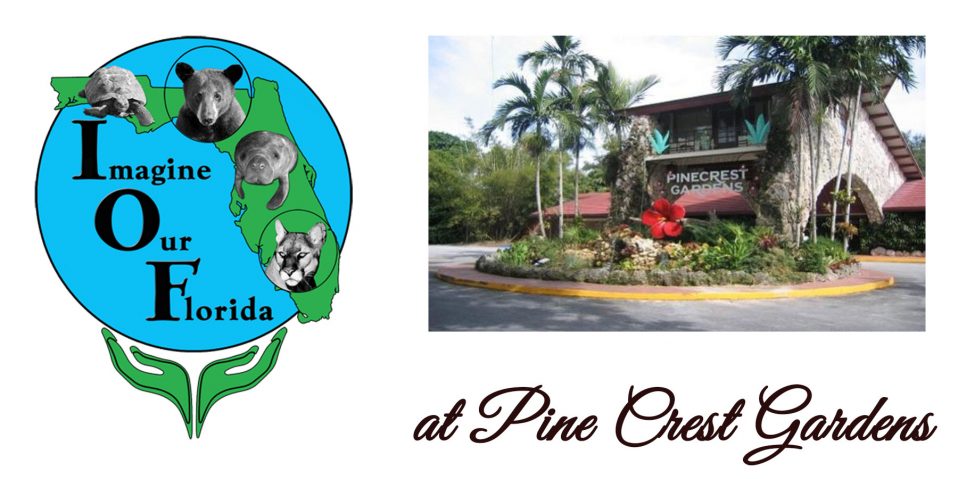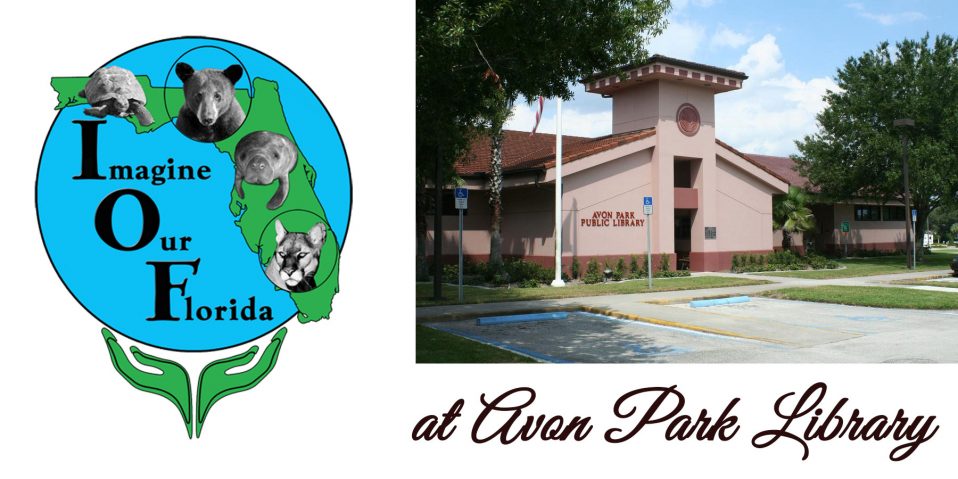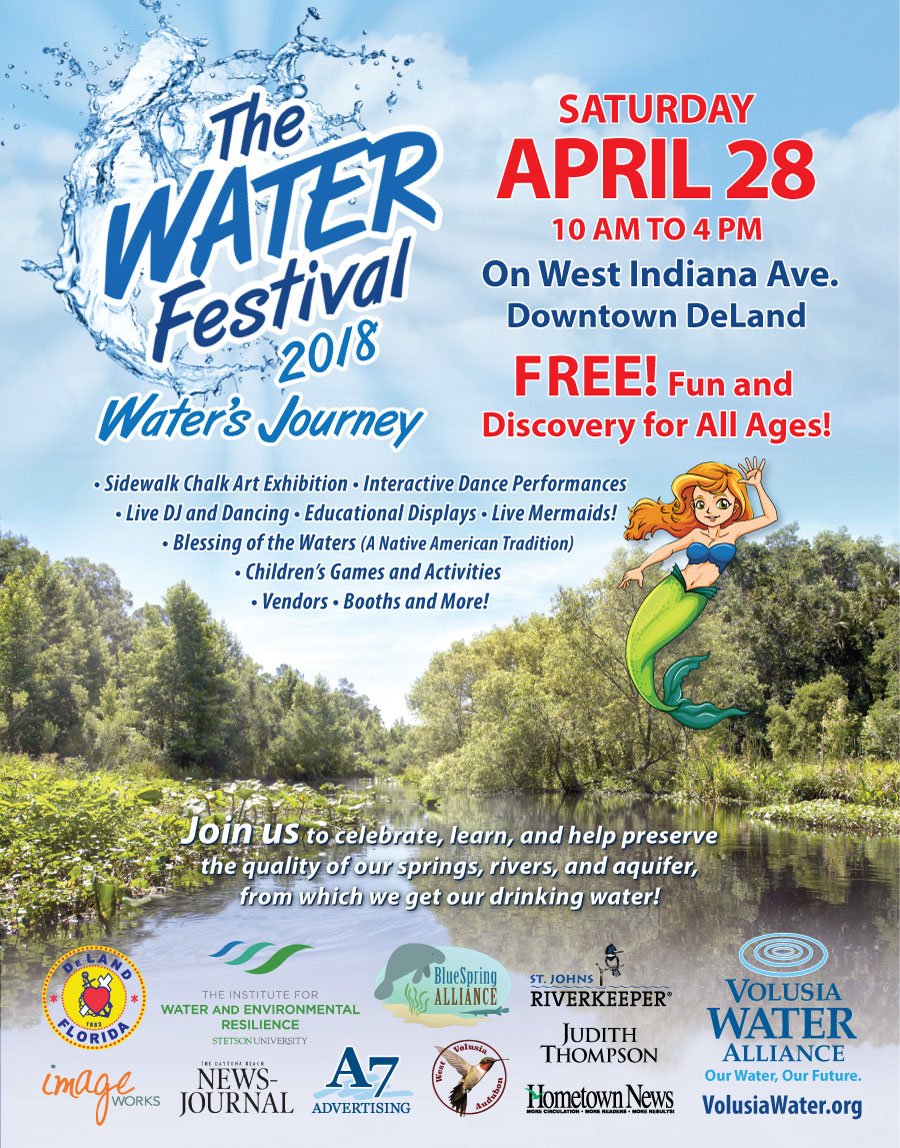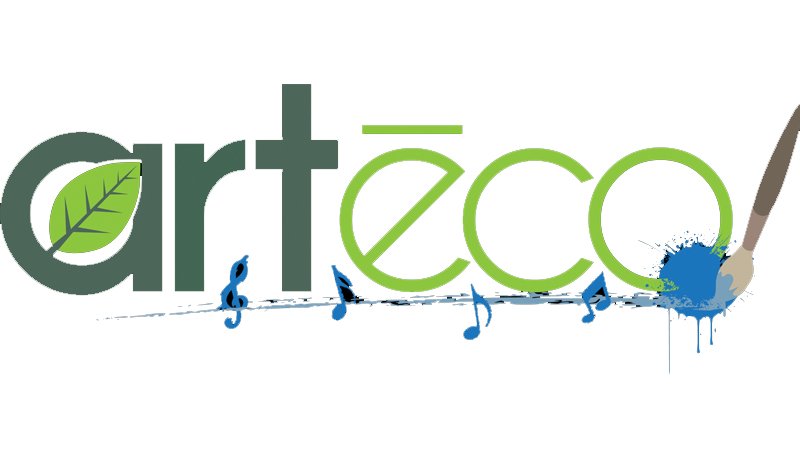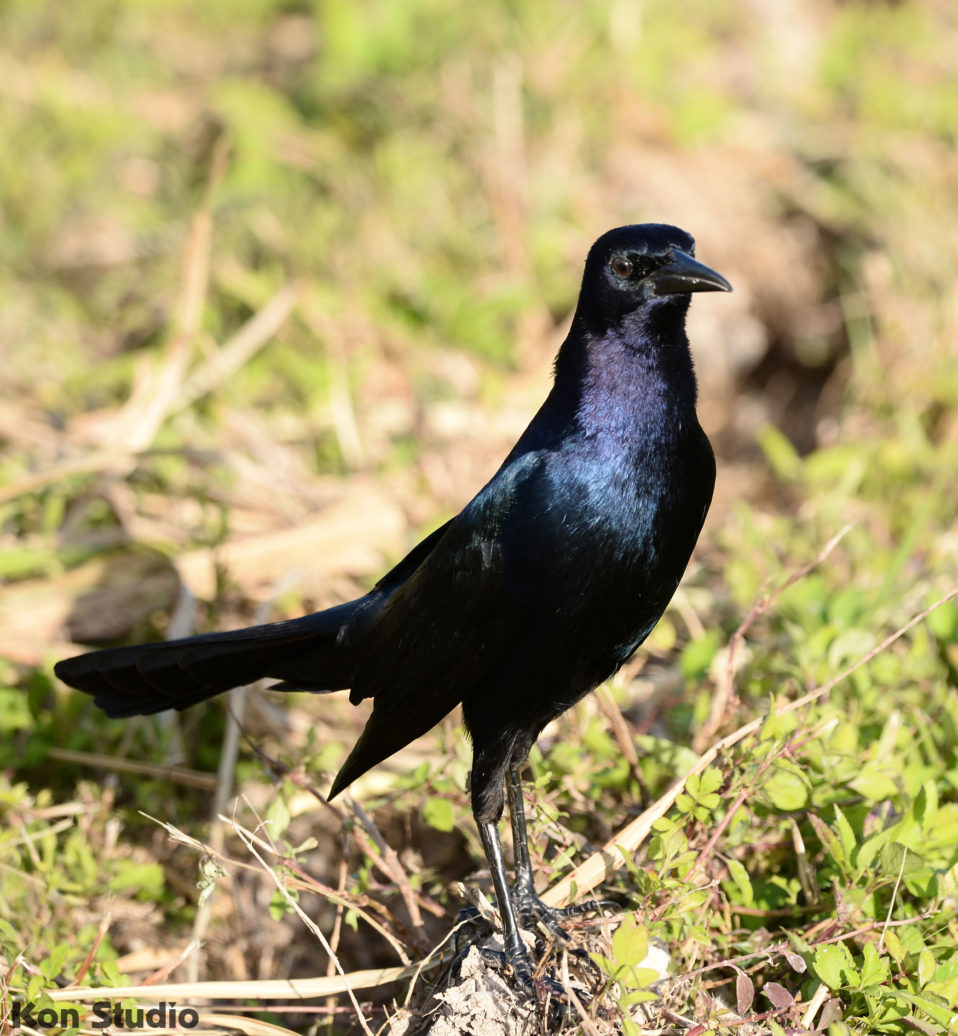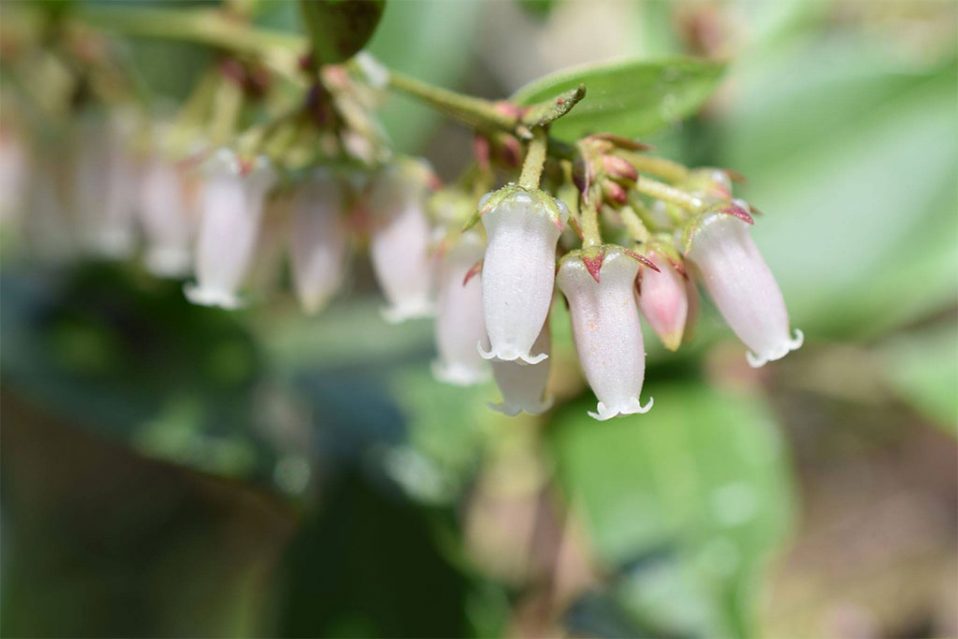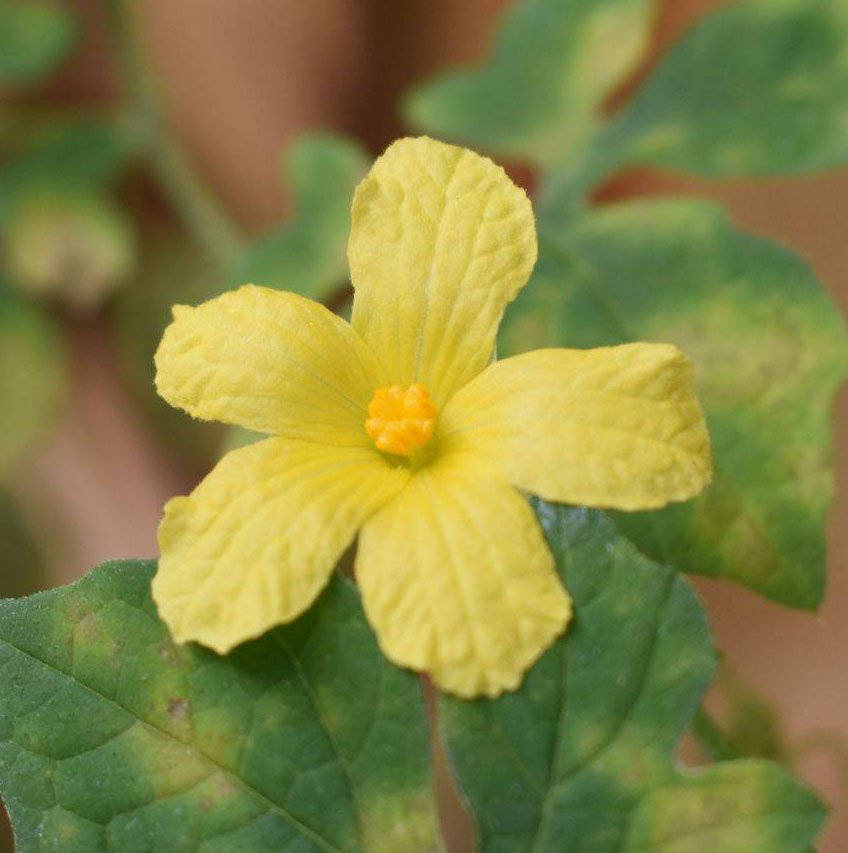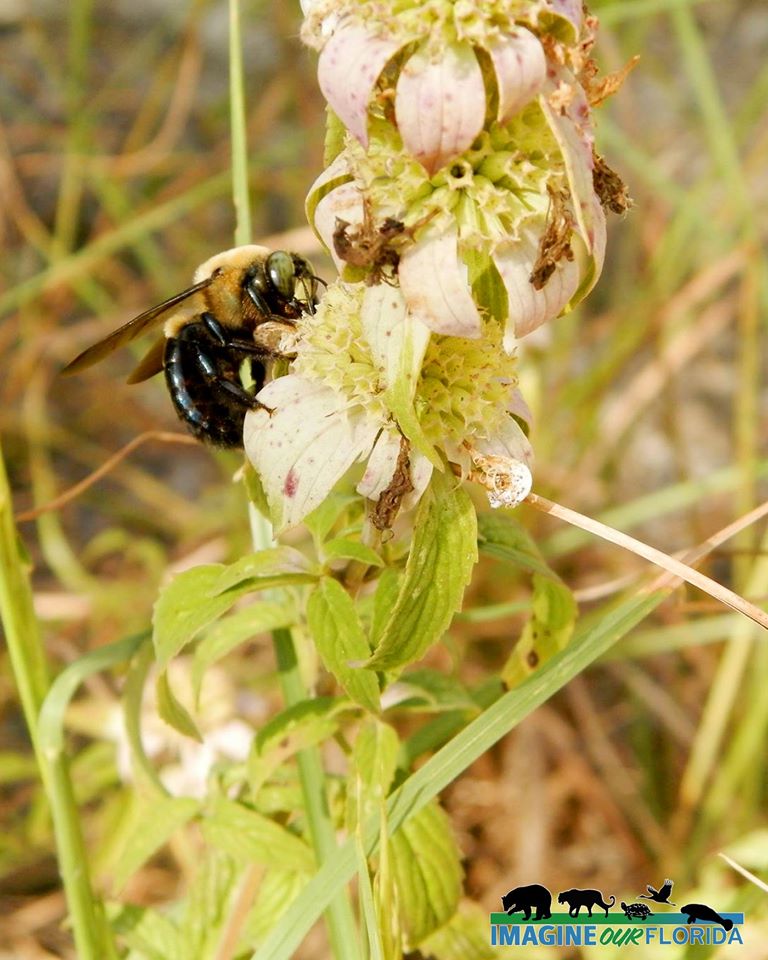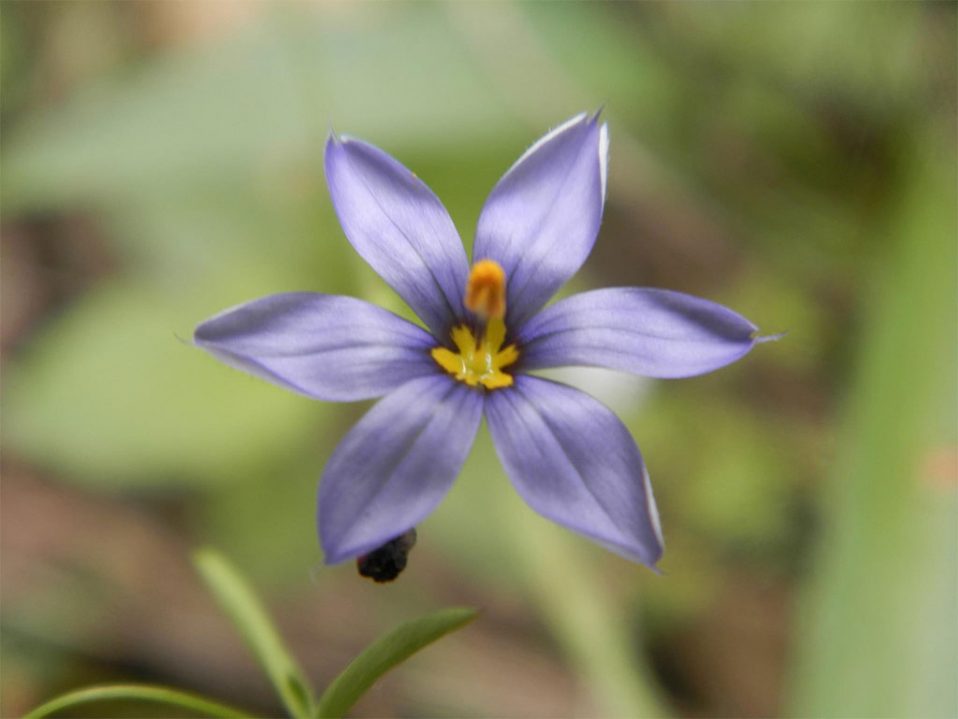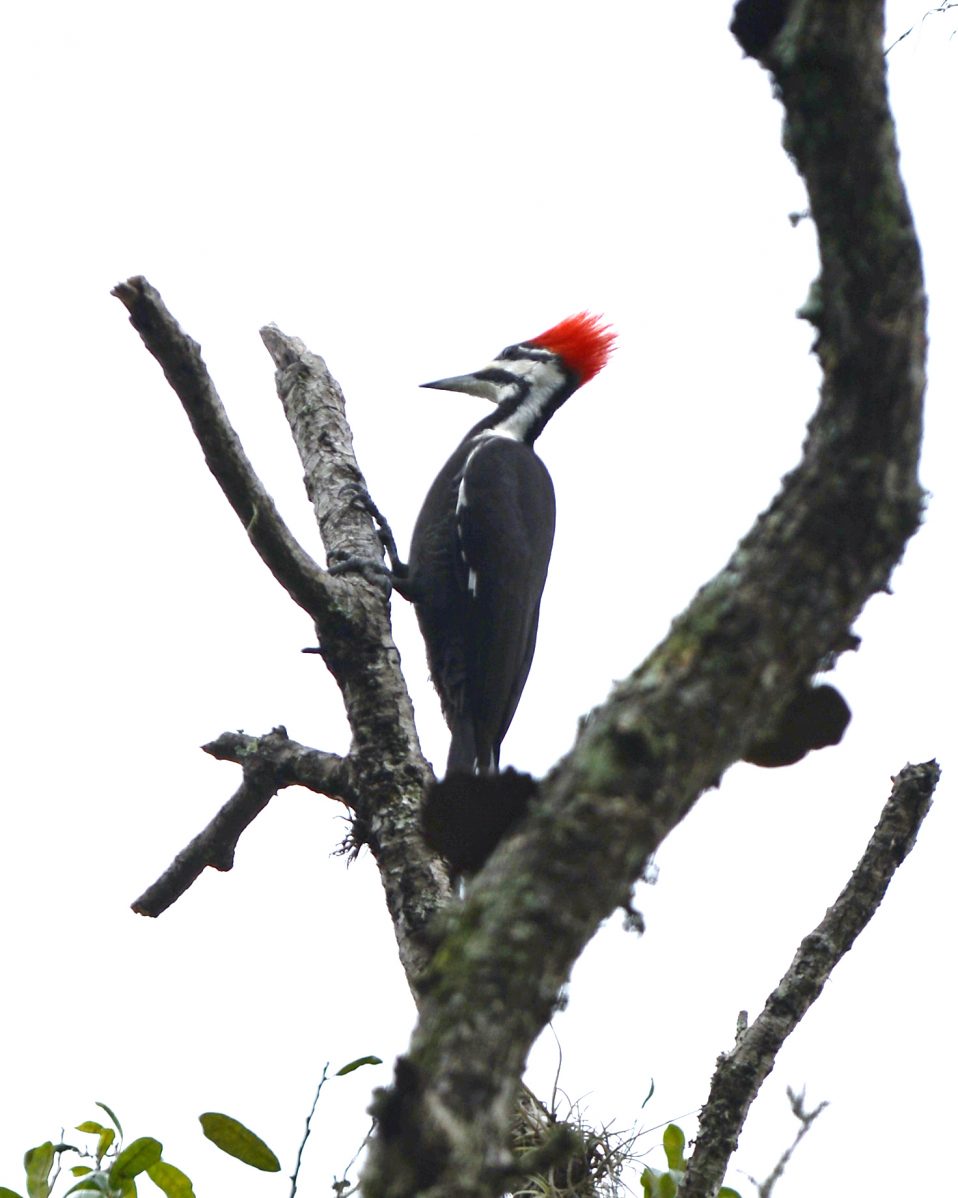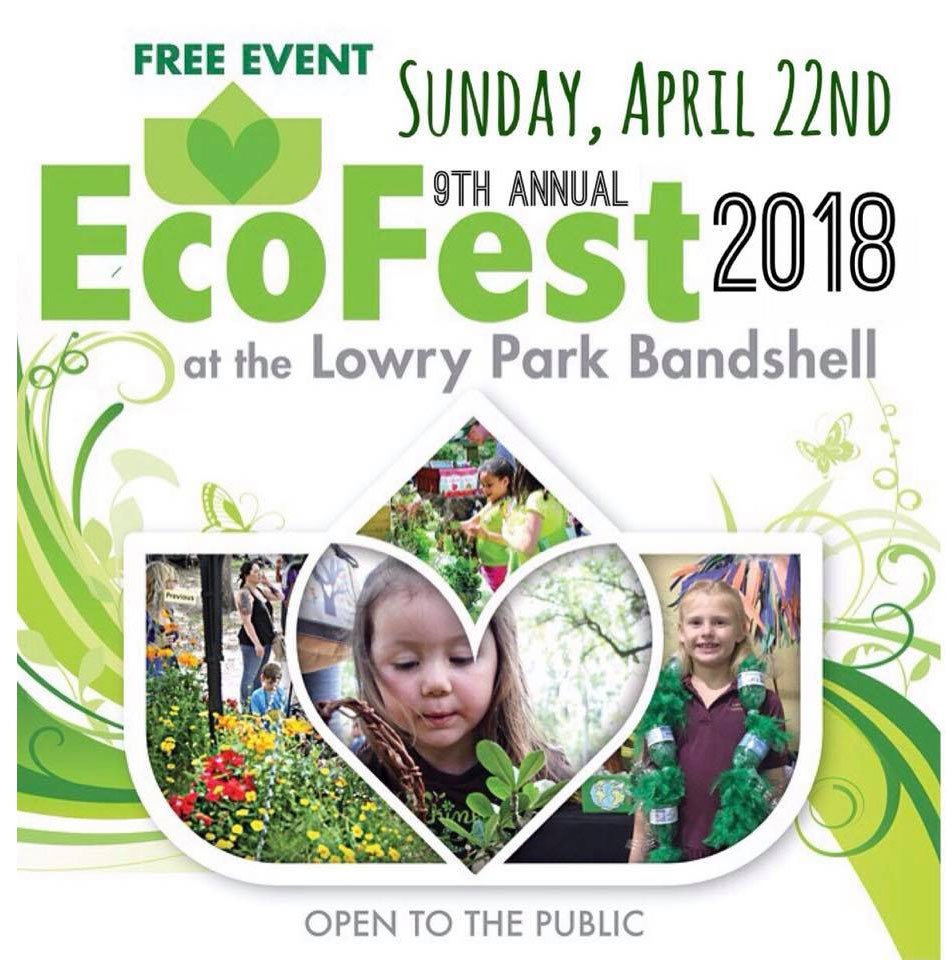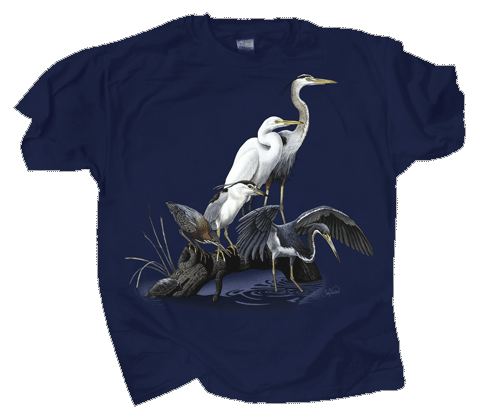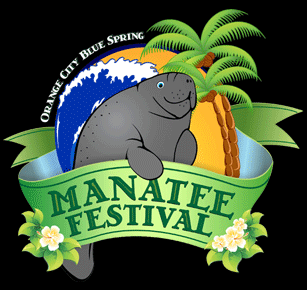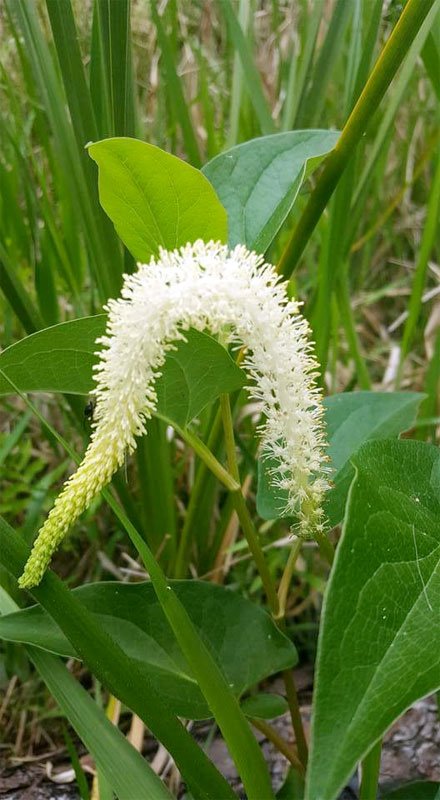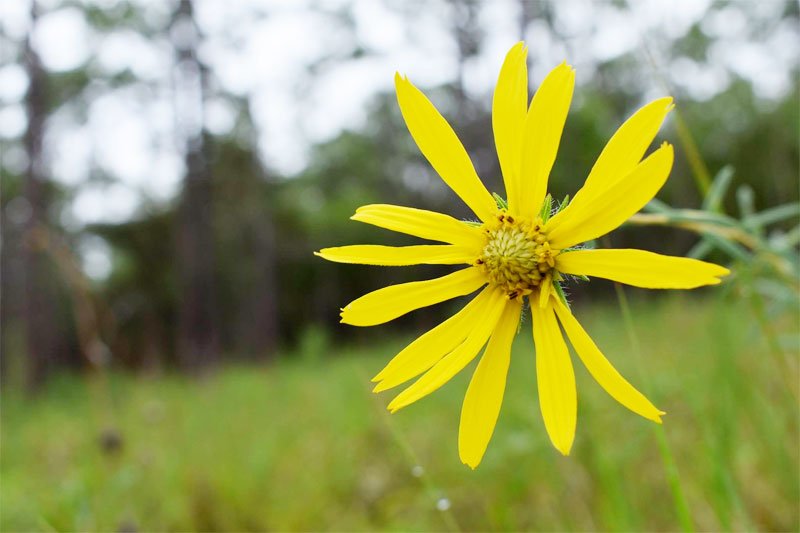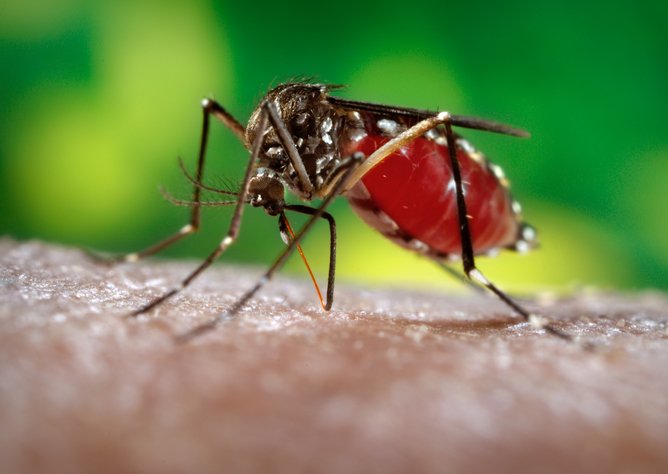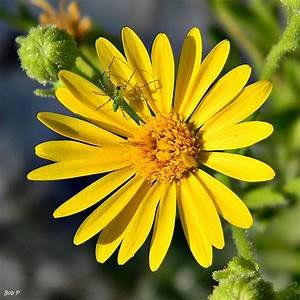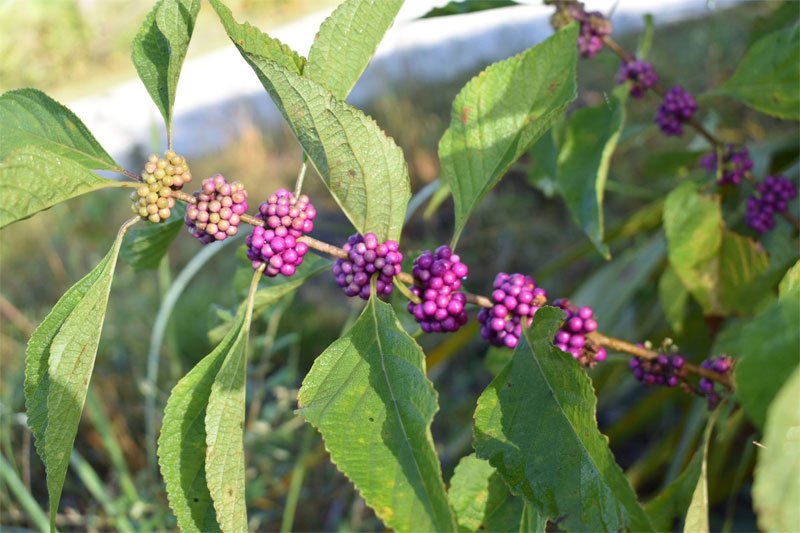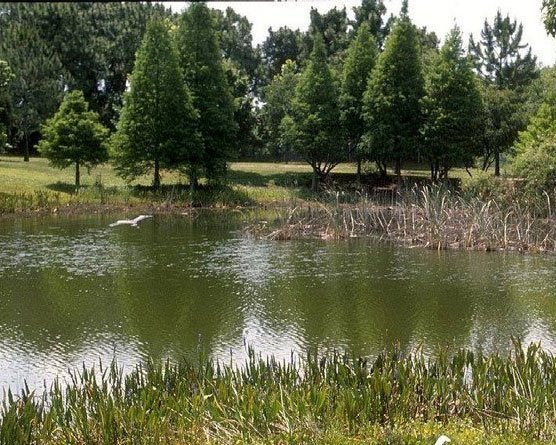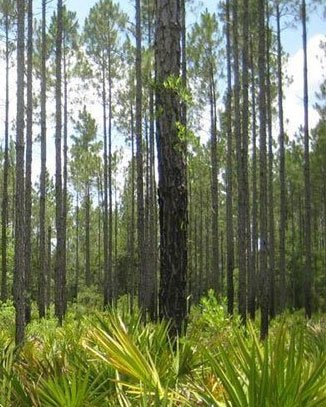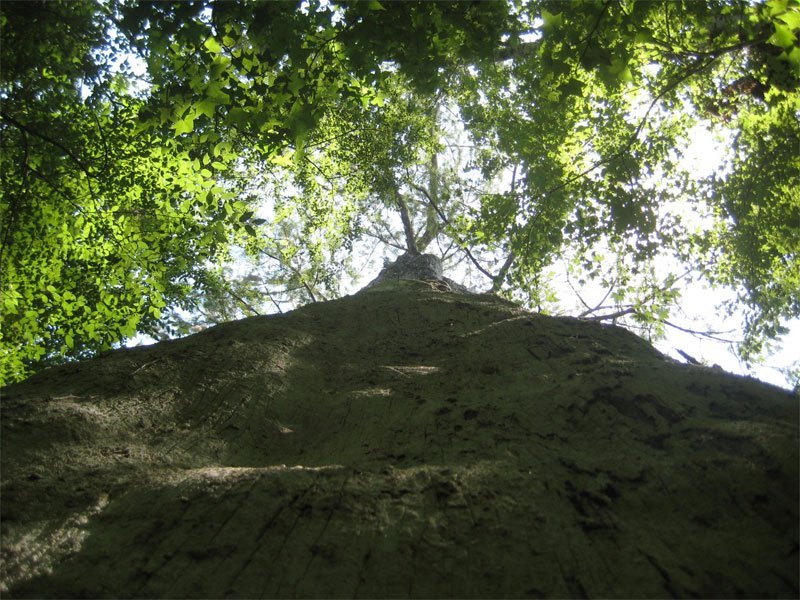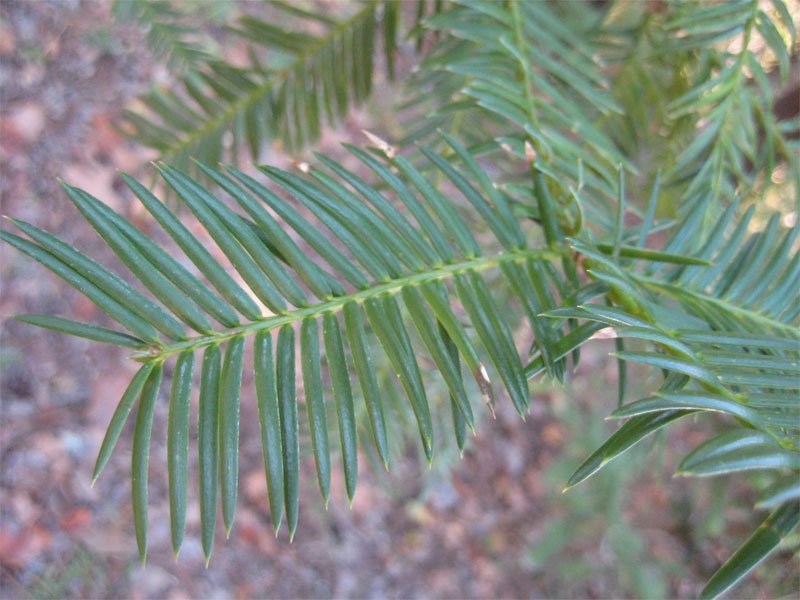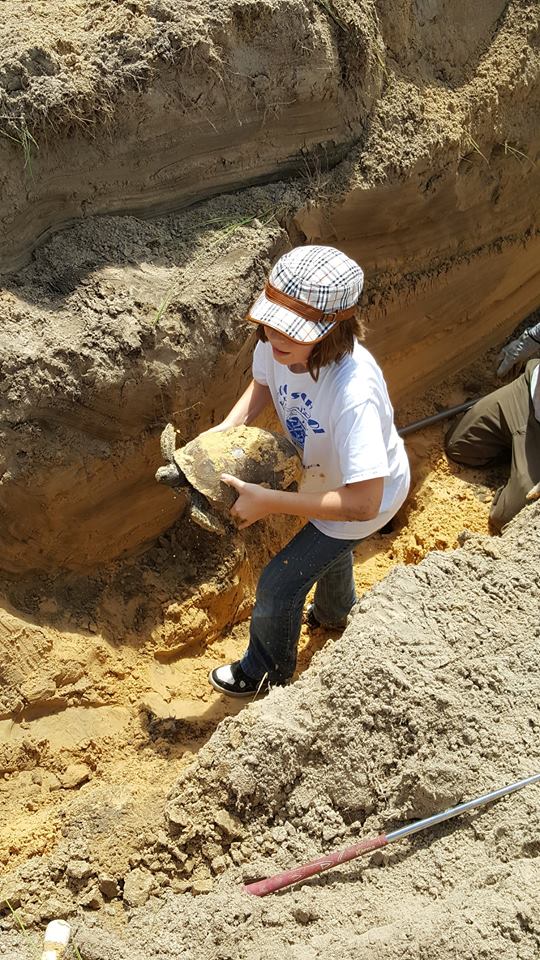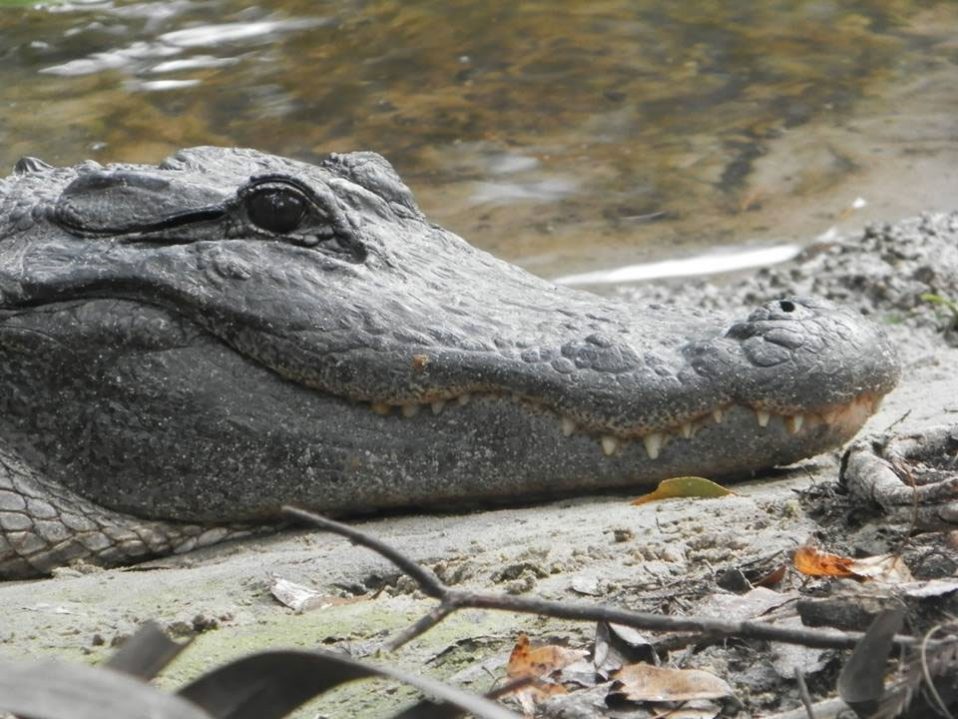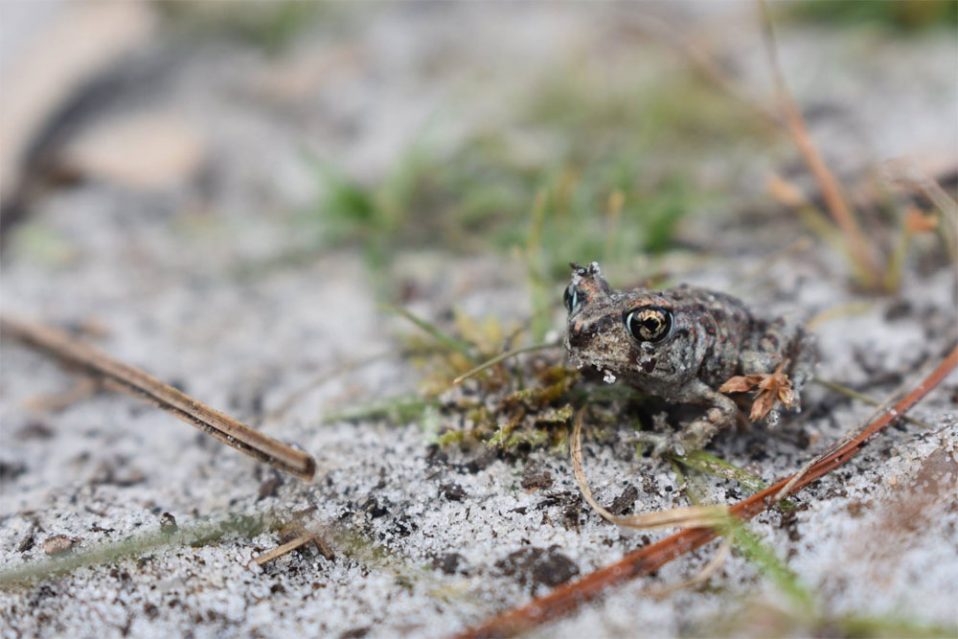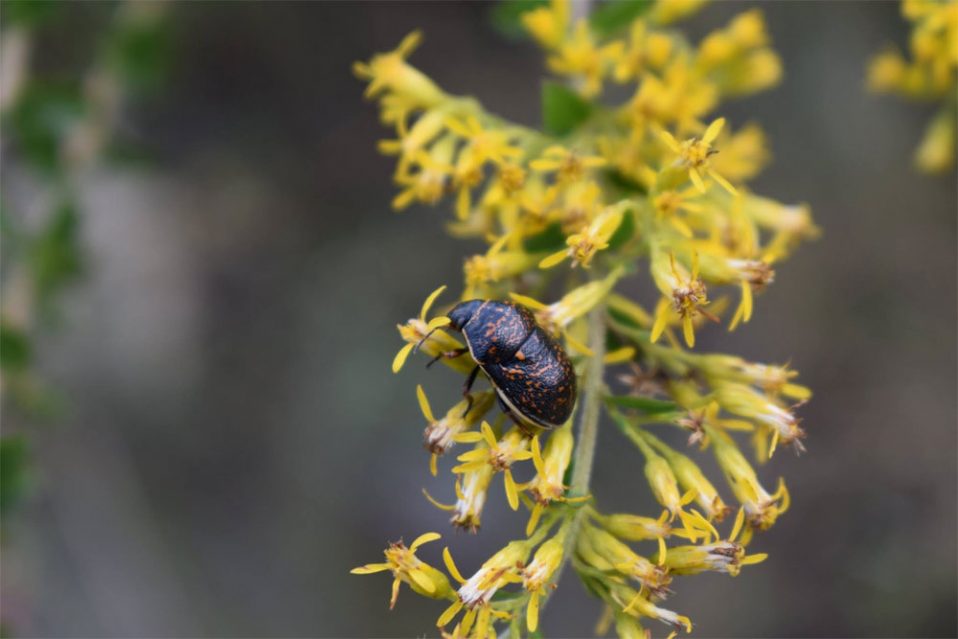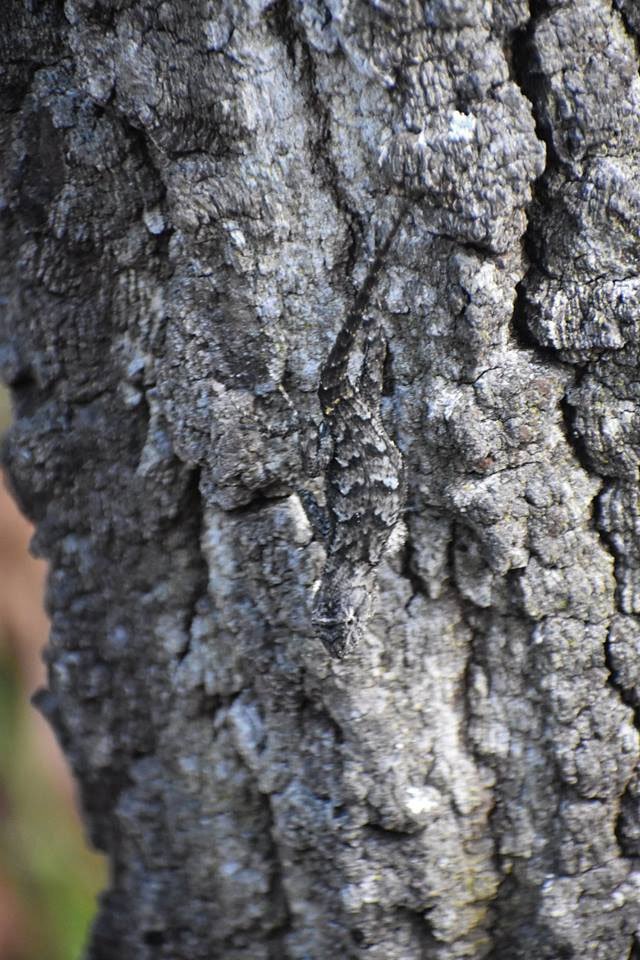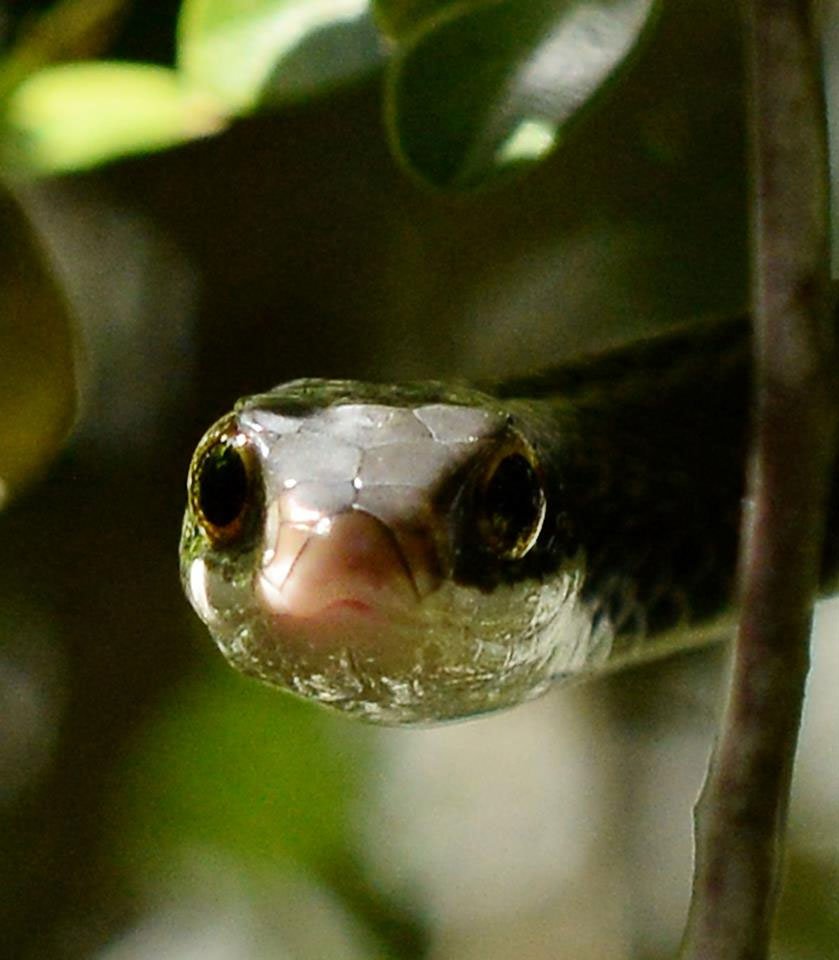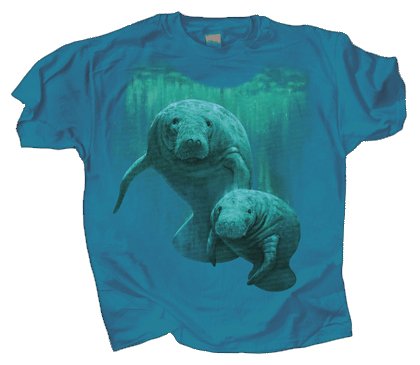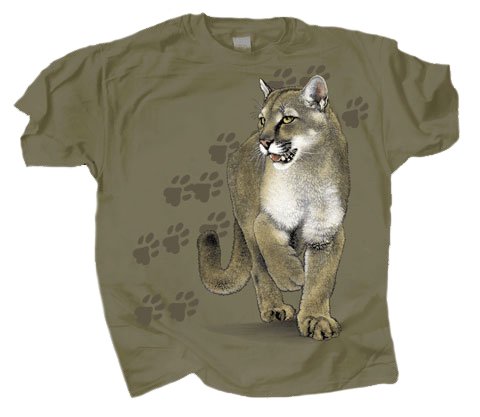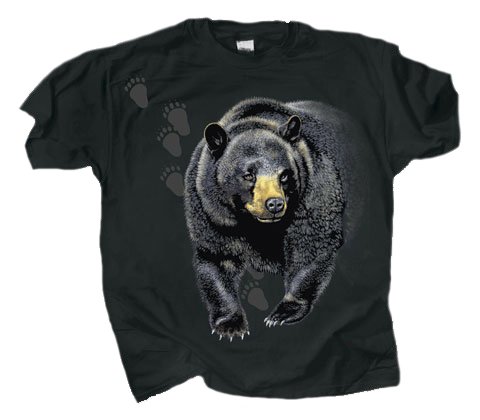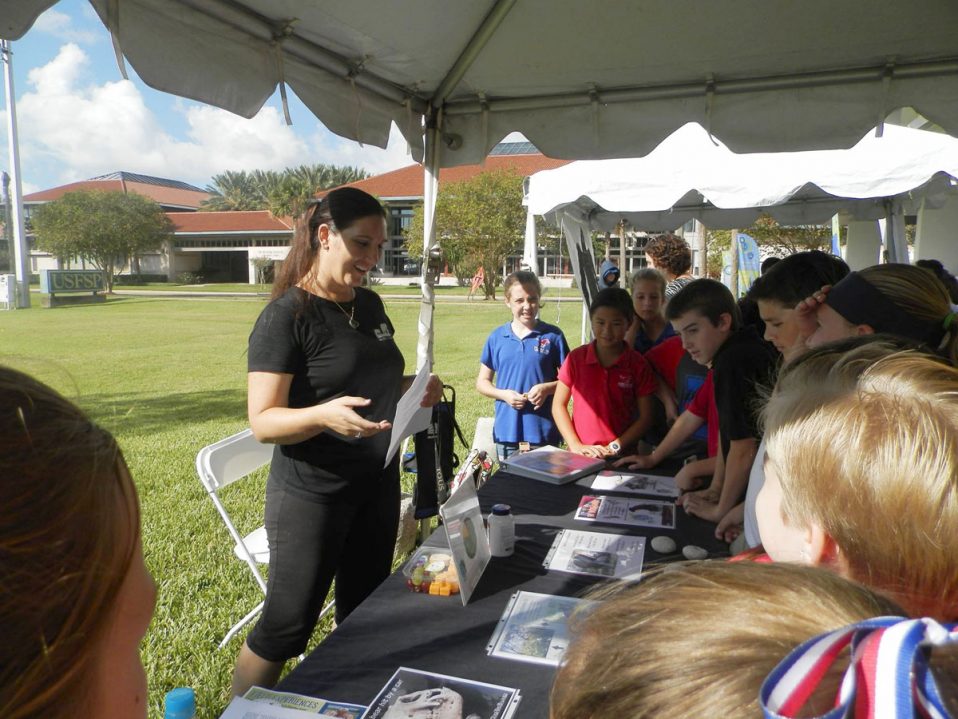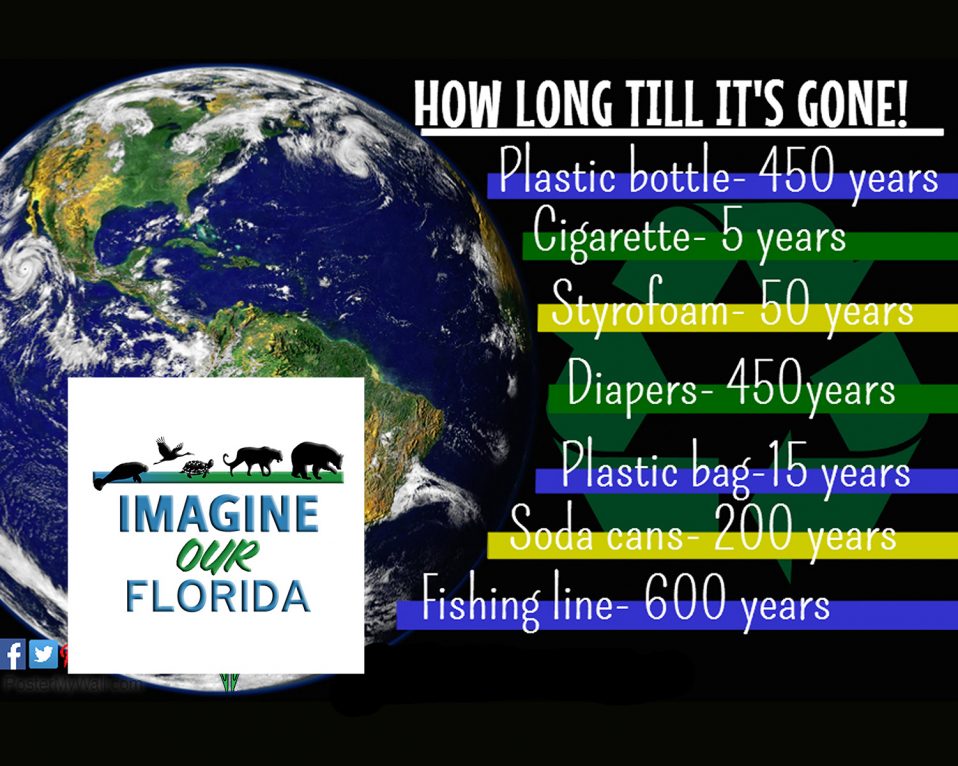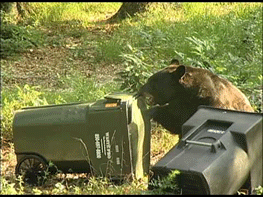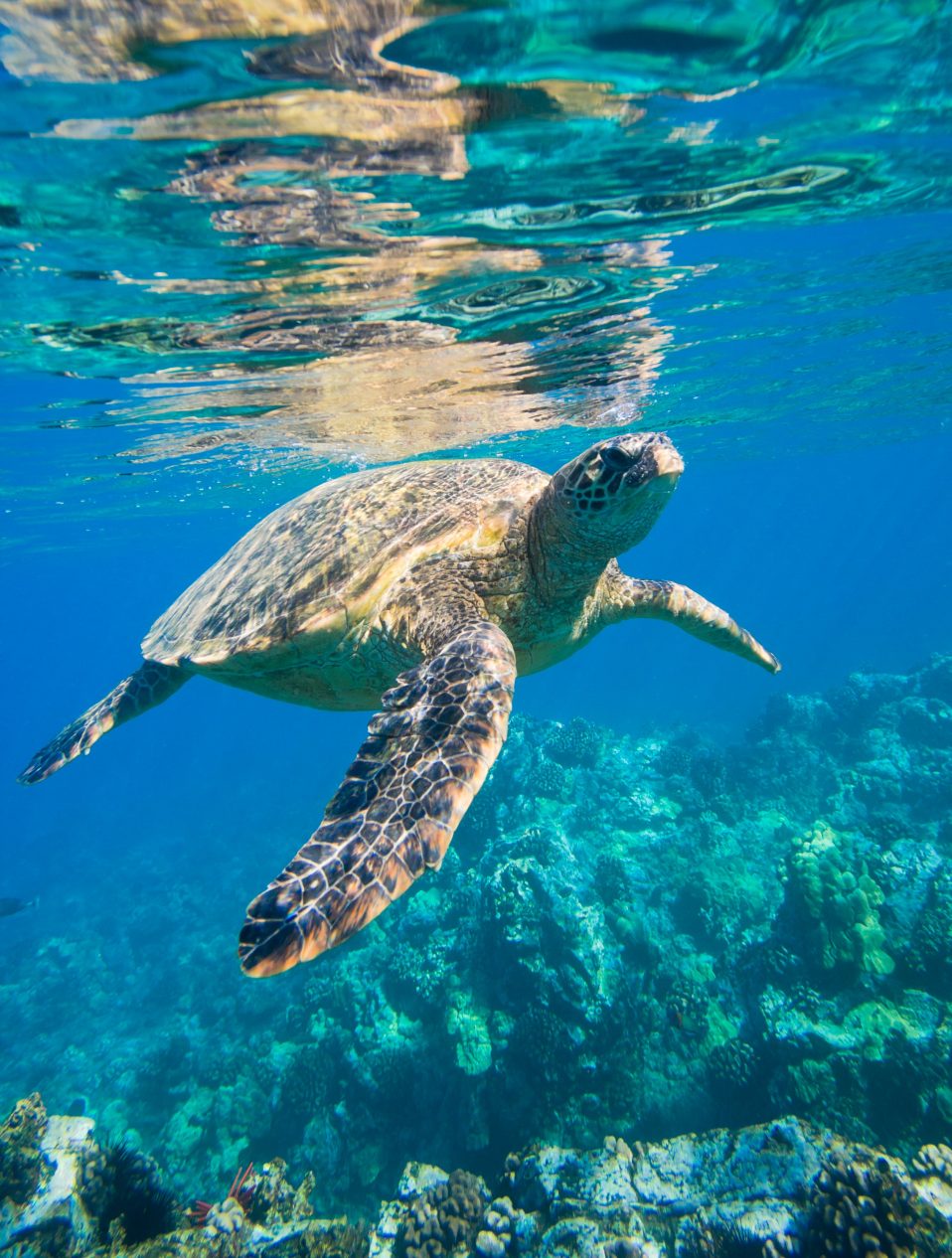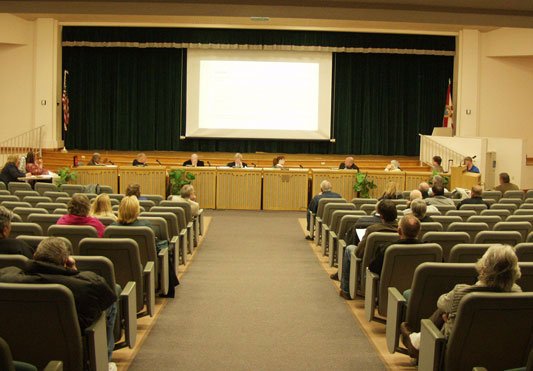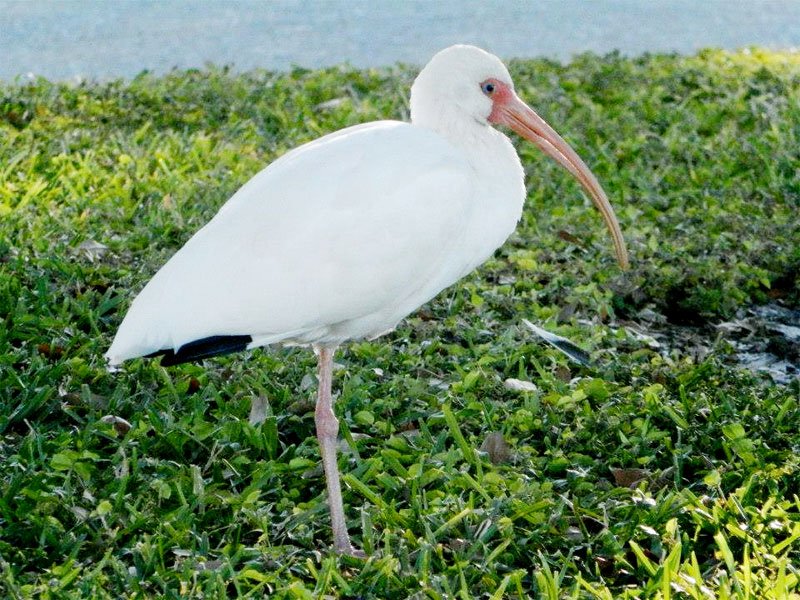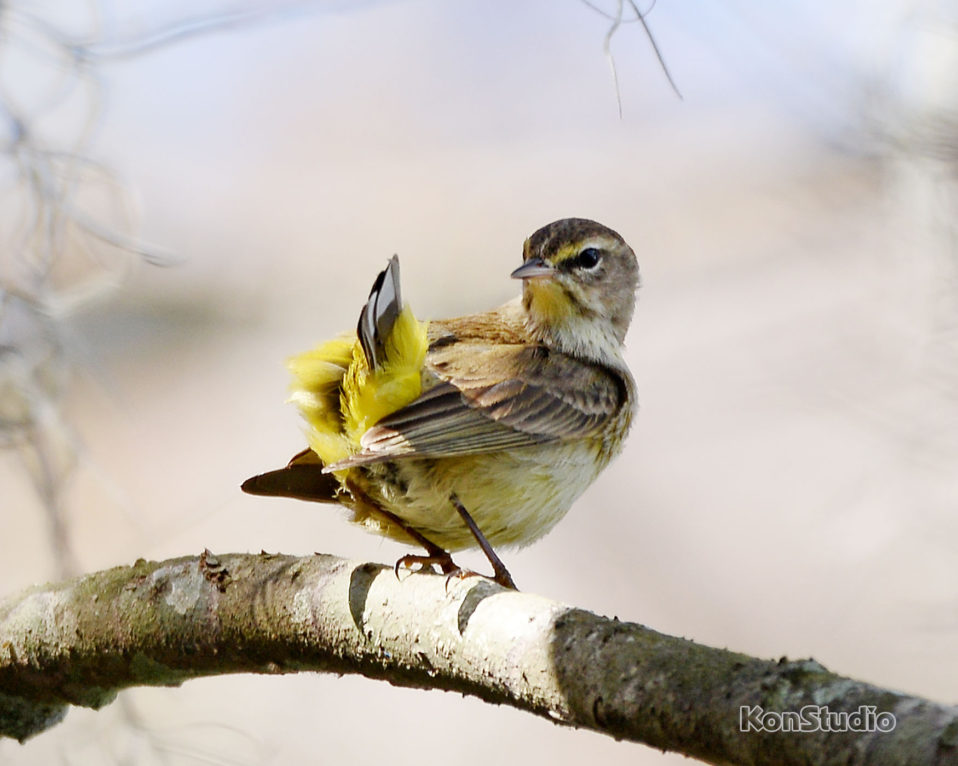Blue-Green Weevil (Pachnaeus litus). These little bugs get a bad reputation, but such is the life of a weevil—the adults, such as this one, munch on plant leaves. The larvae fall to the ground and will munch on roots. This can be quite annoying in agriculture, especially citrus. For most plants, they aren’t much of a problem, but if they seem to get overwhelming, the USDA recommends the Trichogrammatidae family of wasps can help by preying on their eggs.
Moorhen (Common)
The Common Moorhen (Gallinula chloropus), also known as Marsh Hen, is a medium-sized bird. It is migratory in some parts of the U.S., Canada, South America, Europe, Asia, and Africa, but they love Florida and Mexico and stay year-round. The Moorhen, a part of the rail family, spends its life on the water and is usually 12 to 15 inches in size when fully grown. Despite having no webbing on their feet, they are good swimmers. Of course, you can not miss them with their gray-black feathers, a line of white feathers, and a red bill with a yellow tip. Moorhens are omnivores and love to eat seeds and other plant material floating on the water. They also eat algae, small fish, tadpoles, insects, aquatic roots, berries, grass, snails, insects, rodents, lizards, and worms. On land, you will see them ‘peck’ like a chicken for their food. Moorhen pairs are monogamous. Females will lay 4 to 12 eggs, laying only one egg a day. The chicks will fledge within 5 to 7 weeks, and Momma Moorhen might have another brood later in the season. Predators such as foxes, dogs, coyotes, and raccoons are the main predators of the moorhen. Large reptiles and Wildcats may also prey on them. Here you see a moorhen family on the water’s edge.
Umatilla Wildlife Festival 2018
Come and experience the “Real” Florida at the original “wildlife focused” festival The purpose of the Florida Wildlife Festival is to increase awareness and promote the safe coexistence of humans and wildlife by fostering community appreciation of the Florida black bear and other native wildlife species, as well as Florida’s unique ecosystems that serve as wildlife habitat.
Wild Weather Weekend
The Orlando Science Center has invited Imagine Our Florida to present an educational program to talk about the wild weather and Florida’s wildlife and ecosystems. There will be other educational information from others organizations too. For more information http://www.osc.org/september/
Privacy Policy
Web Site Terms and Conditions of Use 1. Terms By accessing this web site, you are agreeing to be bound by these web site Terms and Conditions of Use, applicable laws and regulations and their compliance. If you disagree with any of the stated terms and conditions, you are prohibited from using or accessing this site. The materials contained in this site are secured by relevant copyright and trade mark law. 2. Use License Permission is allowed to temporarily download one duplicate of the materials (data or programming) on Imagine Our Florida, Inc.’s site for individual and non-business use only. This is the just a permit of license and not an exchange of title, and under this permit you may not: modify or copy the materials; use the materials for any commercial use , or for any public presentation (business or non-business); attempt to decompile or rebuild any product or material contained on Imagine Our Florida, Inc.’s site; remove any copyright or other restrictive documentations from the materials; or transfer the materials to someone else or even “mirror” the materials on other server. This permit might consequently be terminated if you disregard any of these confinements and may be ended by Imagine Our Florida, Inc. whenever deemed. After permit termination or when your viewing permit is terminated, you must destroy any downloaded materials in your ownership whether in electronic or printed form. 3. Disclaimer The materials on Imagine Our Florida, Inc.’s site are given “as is”. Imagine Our Florida, Inc. makes no guarantees, communicated or suggested, and thus renounces and nullifies every single other warranties, including without impediment, inferred guarantees or states of merchantability, fitness for a specific reason, or non-encroachment of licensed property or other infringement of rights. Further, Imagine Our Florida, Inc. does not warrant or make any representations concerning the precision, likely results, or unwavering quality of the utilization of the materials on its Internet site or generally identifying with such materials or on any destinations connected to this website. 4. Constraints In no occasion should Imagine Our Florida, Inc. or its suppliers subject for any harms (counting, without constraint, harms for loss of information or benefit, or because of business interference,) emerging out of the utilization or powerlessness to utilize the materials on Imagine Our Florida, Inc.’s Internet webpage, regardless of the possibility that Imagine Our Florida, Inc. or a Imagine Our Florida, Inc. approved agent has been told orally or in written of the likelihood of such harm. Since a few purviews don’t permit constraints on inferred guarantees, or impediments of obligation for weighty or coincidental harms, these confinements may not make a difference to you. 5. Amendments and Errata The materials showing up on Imagine Our Florida, Inc.’s site could incorporate typographical, or photographic mistakes. Imagine Our Florida, Inc. does not warrant that any of the materials on its site are exact, finished, or current. Imagine Our Florida, Inc. may roll out improvements to the materials contained on its site whenever without notification. Imagine Our Florida, Inc. does not, then again, make any dedication to update the materials. 6. Links Imagine Our Florida, Inc. […]
2018 Central Florida Vegfest
Central Florida Veg Fest is an exciting day of colorful and educational exhibits and activities! It will take place at the beautiful Orlando Festival Park near downtown Orlando on October 27, 2018 from 10:00 a.m.-6:00 p.m. Admission is FREE! Veg Fest is a family-friendly, dog-friendly, alcohol-free, and smoke-free event. Veg Fest, now in its 13th year, is one of the biggest and best vegetarian festivals in the country! Central Florida Veg Fest will draw both committed vegetarians/vegans and those who want to learn more about how veg-living enhances our health, the planet, and its inhabitants. Come enjoy a diverse cross-section of vegetarian cuisines and lifestyles. Discover new products and ideas from over 200 vendors and 100 contributors and enjoy a wide variety of presentations and food preparation demos. Not a vegetarian? Whether you’re looking for new ideas to add color and variety to your meals or you’re a “seasoned” vegetarian interested in expanding your knowledge of nutritious and ethical foods, this is the place for you. Please RSVP on the Veg Fest event page and join the Veg Fest community page for regular updates about the event. And please share these pages with your family and friends. Enjoy speakers, food preparation demonstrations, a veggie kids zone, an animal haven, an artist corner, music on an acoustic stage, lots of other activities (including parades, performances, workshops, and a drum circle presented by Earth Sponsor and special guest Ibex Puppetry!), and many veg-friendly vendors. There are so many fun and interesting things happening at Veg Fest you will want to stay all day. And so much delicious vegan food that you can have breakfast, lunch, and dinner with plenty of snacks in between!
Open Letter to the FWC on land based shark fishing proposal
Dear Commissioners, I wanted to express concerns regarding the land-based shark fishing proposal. While many important concerns
An Open Letter to Santa Rosa County Commissioners about living with bears and bear resistant cans
— An Open Letter to Santa Rosa County Commissioners — Imagine Our Florida Inc.’s response to the Santa Rosa’s Press Gazette article titled Santa Rosa commissioner
Southern Five-Lined Skink
Adult Southern Five-lined Skink. This fella is in the process of regenerating his tail. Young skinks have a bright blue tail, which detaches when a predator tries to capture them. This gives them a chance to get away. As they get older, skinks get a reddish head, and the stripes on the males fade. These lizards move fast, so keep your eyes open when exploring damp trails.
Monarch Butterfly
The Monarch Butterfly population is in trouble due to loss of habitat, pesticides, and climate change. As the only butterfly which migrates, a single monarch can travel hundreds to thousands of miles. Monarchs are born with an internal compass that guides them on their migration. Each year, three to five generations will be born. A Monarch’s lifespan is6 – 8 months but will live only 2-6 weeks as a butterfly. —— You can Make a Difference —– Plant native milkweed and nectar plants that have been grown organically. Milkweed contains glycoside toxins that are harmless to the Monarchs but is poisonous to its predators. —– Conservation Begins in Your Backyard ——
Witch’s Broom
Witches’ brooms are caused by stress on the plant. Trees can be infected by a fungus, phytoplasmas (which are wall-less single-celled organisms), or parasitic plants like mistletoe. These structures can benefit wildlife, providing shelter for animals such as flying squirrels. There are also species of moths that rely on these for shelter and food for their larva. Cutting from witches’ brooms can be grafted onto normal rootstocks, creating weird dwarf cultivars that people collect. The photos here are of a Witches’ Broom growth on a sand pine, Pinus clausa in Wekiva Springs State Park.
Lake Wales Ridge
We all know Florida has some very unique ecosystems. One of the most unique of these ecosystems is The Lake Wales Ridge. The ridge runs about 150 miles along the spine of Central Florida. The city of Lake Wales is located roughly at its center. The highest point of the ridge is Sugarloaf Mountain. At an elevation of 312 feet., this is the highest point in peninsular Florida. As you can see in the satellite image, the ridge is actually visible from space as a bright white line. This line is caused by the dune sands of this former island chain. That’s right! The Ridge used to be a chain of islands 2 million years ago when the rest of the peninsula was under the raised waters of the ocean. These ancient dunes and their white, powdery sand, provide a unique habitat for many rare and endangered plants and animals. These plants and animals have evolved to deal with hot conditions and quick-draining soil. Species such as the scrub jay, gopher tortoise, Florida scrub lizard, and sand skink make their homes here. Many of the plants have also adapted to the heat and lack of regularly available water. Scrub oaks have thick, curved leaves adapted to conserve water. Yucca, pear cactus, and scrub palmetto are all common plants along the ridge. Photo Credit: Andy Waldo
Black Soldier Fly
Black Soldier Fly Many confuse the black soldier fly (Hermetia illucens) with wasps. However, like many other flies, this species only has two wings, while wasps have four wings and do not have a stinger. The black soldier fly produces a loud buzzing sound when flying, which may concern people, but they are not dangerous. Black soldier flies usually gather around decaying organic matter such as animal waste or plant material. Eggs are laid in decay matter since it is a food source for the larvae. Black soldier fly larvae have been used to reduce animal manure in agricultural facilities. Even though they are not considered a disease vector, adult soldier flies are potential mechanical vectors of many pathogens. The black soldier fly is abundant in the southeastern United States during late spring and early fall. The natural breeding sites for black soldier flies are carrion; they lay their eggs in moist organic waste. In urbanization areas, they will lay eggs in dumpsters or compost, providing similar orders and nutritional needs to naturally occurring organic matter. Adults come in a variety of colors, from yellow, green, black, or blue; some can have a metallic appearance. Adults can measure from 15 to 20 mm in length. The antennae are long with three segments, and the legs have white coloration near the end of each leg. Mating starts two days after they emerge from the pupal case. Males will gather in areas where females will be abundant, known as lekking sites. The sites are defended against other males. Females lay up to 500 eggs! These eggs will be laid in cracks and crevices near or on decaying matter. Eggs will hatch in about four days. The larvae are a dull, whitish color with a small, projecting head containing chewing mouthparts. There are six instars, and it takes up to 14 days for complete development. During their development, like many other larvae species, the black soldier fly larvae are insatiable feeders. When adults, they do not feed and rely on fats stored from their larval stage. Before pupation, the fifth instar larvae will leave its feeding site to dryer areas, then pupation will start, the exoskeleton darkens, and a pupa develops. Pupation lasts for two weeks. Cool Fact! Black soldier fly larvae generate good sources of protein and oil for animal feed; they also have the potential to improve organic waste into rich fertilizer. Photo Credit: Dan Kon Author: Destiny Alvarez – Fisheries and Wildlife Sciences, University of Oregon
Giant Air Plant
This cool-looking plant is Tillandsia utriculata, or the Giant Airplant. Its status in Florida is Endangered (listed as a result of the Mexican bromeliad weevil attack). This one was still small, only about 18 inches in height but these can get up to 2 meters long. When they mature, they produce a single flower spike then die. Lake Wales Ridge is home to many rare and endangered plants and animals. Make sure to get out and explore. Use our state parks, wildlife management areas, and National parks. This shows government officials how valuable natural spaces really are to people. Attendance matters.
Red Shouldered Hawk
Red-shouldered hawks, Buteo lineatus, are most vocal in the spring. Listen for their distinct sound in forests and neighborhoods with large trees. Look for them sitting silently on perches below the canopy of the trees. You may see them on streetlights or tall fences in neighborhoods. Watch as they fly low or swoop down to catch a reptile, amphibian, or small mammal. Voles, mice, rats, squirrels, snakes, large insects, and an occasional bird at your bird feeder are some of the dietary choices for Red-shouldered hawks. Mated pairs build their nest 35 – 65’above ground in the sturdy fork of a tree. The nest, which may be used more than one season, is constructed of sticks and other found materials. It may be lined with moss, bark, and fresh spring greens. The female is most responsible for incubating the couple’s 2 to 5 eggs while the male hunts and brings food to the female. Once the chicks are born, the male continues to bring food and the female feeds the young for 1 -3 weeks. At 5 – 7 weeks, the young leave the nest and the parents continue to feed them for up to 10 more weeks. Red-shouldered hawks are common in Florida, however, the continued loss of habitat due to urbanization is a concern. Photo Credit: Dan Kon
Black and Yellow Garden Spider
Here’s a little girl that many people will be quick to recognize. She’s a young black and yellow garden spider. These spiders range all across the United States and up into Canada as well as south into Mexico and Central America. The spiderlings emerge in spring from egg sacs laid the prior year. The dense zigzag of silk in the middle of the web is known as the stabilimentum. The true purpose of this structure is in dispute. Some say it is to provide camouflage to the spider resting in the center. Others think it acts as an attractant to insect prey or a deterrent to birds who could fly into the nest and damage it. Every night, the female eats the center of her web and then rebuilds it in the morning. Their bites are comparable to a bee sting and are harmless to healthy adults and those who are not allergic to their venom. They maintain a clean and orderly web and help remove loads of insects. They are great to have around and are a truly beautiful arachnid. We hope everyone gets a chance to get out this weekend and enjoy the outdoors!
Little Brown Cicada
Cicadas are some pretty neat little creatures that are all around us but go largely unseen. They do not, however, go unheard. I bet, at some point, just about everyone has heard these guys screaming from the treetops at some point in their lives. But did you know that most of their lives are spent underground? The species in the photos are of the Little Brown Cicada (Cicadetta calliope) or Grass Cicada. This is a small species of cicada, growing to just under 1 inch in size. Unlike its larger cousins to the north, this is not a periodical cicada. Those cicadas emerge every 13 to 17 years in numbers as great as 1.5 million per acre. For our residents who hail from the northeast, Florida has no periodical species. The closest location to observe the emergence of periodical species would be one of the 13-year varieties. Southeastern Louisiana will have its next emergence in 2027, and in central Alabama and Georgia, the next emergence will be in 2024. So, some cool facts on these amazing insects. We all know their sound, but did you know only the males actually make noise. Cicadas make noise using timbals, a drum-like structure on either side of their abdomen. Only males possess this structure. They make different songs, calling songs to attract mates, protest songs when captured by a predator, and in some species, courtship calls, which are softer and made when the male is in visual or physical contact with the female. The nymphs feed on the xylem sap from the roots of grasses and trees. This low nutrient sap is partially the reason for their long duration as a nymph. The minimum time a cicada spends as a nymph is 4 years but, in the case of the periodical cicada species, can be as long as 17 years. Every cicada species molts 4 times as a nymph. For its fifth molt, the nymph emerges from the ground and molts into its adult form. Cicadas do little to no harm to plants. They are harmless to food crops and landscape plants. They do not bite or sting and are an important food source for wildlife. Watch our video here: https://youtu.be/be80lm4fn7k
Florida Softshell Turtle
This Florida Softshell Turtle (Apalone ferox) made her way into a human neighborhood. Softshell Turtles will lay their eggs under the edge of a driveway or sidewalk. The sun will warm the concrete and keep her eggs warm until they hatch. If you see a Softshell Turtle in your neighborhood, give her space, and she will make her way back to the pond where she makes her home. Softshell Turtles usually eat snails and small fish but have been known to eat waterfowl such as ducks and small herons. Florida Softshell turtles will hide in the sand at the bottom of lakes and streams and ambush passing schools of fish for lunch or dinner. Softshells take 10 years to reach full maturity. They play the role of predator and scavenger. Animals who prey on these turtles are raccoons, bears, other turtles, skunks, snakes, eagles, otters, armadillos, and alligators. Their biggest predators are humans.
Eastern Five-Lined Skink
These pictures might look like different skinks, but they are the same species. In the first picture, you can see that the eggs look painfully larger than the young skink next to them. Don’t worry. They are much smaller when laid. The eggs start small but will swell with water. The eggs are usually laid in a damp location with some burrowed areas around them. You may find them under flower pots or bricks. The second picture shows the vibrant color of the newborn skink. Newborns are about 4 cm in length. The bright colors will fade over time, but juveniles will retain the bright blue tail. You can see the bright coloring has faded in the third picture, leaving just the black and yellow stripes. This skink has just entered adulthood. Females will retain this appearance throughout the rest of their lives. In the fourth picture, you can see a full-grown male skink. The stripes have faded, and the head is a bright red color. These little lizards are very fast, and it’s difficult to see them, but they are fascinating to watch as they hunt for small insects. Much like a cat, they flicker their tail as they stalk their prey.
Eastern Diamondback Rattlesnake
An essential member of Florida’s ecological community, the eastern diamondback rattlesnake is one species almost everyone can identify. Found across the entire state of Florida, including the Florida Keys and several barrier islands, the only snake that looks even a little similar is the timber (otherwise known as Canebrake) rattlesnake. The largest recorded eastern Diamondback was 96 inches (8 feet!) in length. Today, however, you would be considered lucky to see one as large as 6 feet long. They are found in pine flatwoods, longleaf pine, turkey oak, and sand pine scrub areas. These areas are also prime for development. A combination of a loss of habitat and the indiscriminate killing of these snakes by the general public upon site has caused a major population decline. They are currently afforded no protected status in Florida. This is a species that must be respected when encountered. They can strike up to 2/3 the length of their body. Like other snakes, we are not prey to them, and they would be just as happy if we would leave them alone. If you encounter one of these amazing animals, observe from a safe distance, allow it time to pass, or simply walk around it. In the United States, the vast majority of venomous snake bites occur when someone is trying to kill the snake. Attempting to kill these snakes greatly increases your risk of being bitten. They will not chase you and, in fact, are very afraid of you. One of our Facebook friends commented with a wonderful little rule of thumb that I really like, 30/30. Stay 30 feet away for 30 minutes, and they will leave. As he pointed out, this will hold true most of the time so long as they are not waiting for food to go by. Please, give these wonderful creatures the respect they deserve as fellow residents of our great state!
Thread Waisted Wasp
The Thread-Waisted Wasp (Ammophila pictipennis) is an ambush predator that will attack small worms, spiders, or other insects. It carries the prey back to the nest made out of packed dirt and stores it with its eggs. When the eggs hatch, the larvae feed on the treat left by the mother. Adults are excellent pollinators and feed on the nectar from flowering plants, such as this firebush, or small insects, including those pesky aphids. They are relatively docile, but if they feel threatened will attack defensively. However, they would much rather save their energy for something they can eat.
Retrofit Trash Cans and Electric Fence Instructions from FWC
Here are the links: FWC Retrofit Trash Cans http://myfwc.com/media/2384072/combined-retrofitkit-directions.pdf FWC Electric Fence Instructions:http://myfwc.com/media/1333878/electricfence.pdf Imagine Our Florida, Inc. assumes no responsibility and is only sharing information from FWC.
General election – you CAN make a difference – get out and vote
Have courage and vote for what you believe in. Your voice counts and will make a difference.
Early voting starts in most counties in Florida
Make a positive difference – get out and vote. Check with your county on exact dates and times and to find out what precinct you are registered at.
Have courage – get out and vote
This is your chance to make a difference. Every vote counts.
Earth Day at Pine Crest Garden
Stop by Pine Crest to celebrate our magnificent planet. Free to the Public. Be sure to stop by Imagine Our Florida’s table.
Avon Park Library display event
Come see the many items and information about Florida’s amazing Black Bears and other wonderful animals that will be on display at the Avon Park Library from April 17th to the 28th.
Arteco Fest
Artēco Festival Saturday, April 14, 2018 10AM to 4PM presented by Innovation Montessori in the Arts! Entertainment, Food, and Vendor Information COMING SOON Feeling artsy? Feeling earthy? Feeling like enjoying a beautiful Saturday with your family exploring our new campus where vendors and students will be providing inspiration? Look no further than Artēco, our inaugural celebration of all things beautiful and sustainable. Innovation Montessori in The Arts! presents Artēco, a festival of music, food, artistic and environmental exploration and learning! Our school’s musical groups and local talent will entertain throughout the day as guests enjoy scores of artistic and environmentally friendly vendors.
Boat-tailed Grackle
This beautiful male Boat-tailed Grackle is on the lookout at the Lake Apopka Wildlife Drive. He is a permanent resident of Florida. The bright sun makes the beautiful iridescence of his feathers glow for all to enjoy. Females have a brownish coloration and a smaller tail. Boat-tailed Grackles breed abundantly in salt and freshwater marshes along the Atlantic and Gulf coasts. These birds forage on the ground, in shallow water, or in shrubs. They eat arthropods, crustaceans, mollusks, frogs, turtles, lizards, grain, seeds, fruit, and tubers. At times they have been known to steal food from other birds, animals, and humans. They overturn shells and stones with their beaks, dunk their heads in water to catch their prey, and pry open mussel shells. Just like us, they will dunk food like rice, dogfood, or bread before eating it.
Fetterbush Lyonia
Lyonia lucida, the fetterbush lyonia, was blooming away in Wekiva Springs State Park. Their flowers can be white, pink, or red. This is an evergreen shrub and reproduces both by rhizome or by seed. If the soil is very poor, it will reproduce only by rhizome. They like acidic, damp soil and can be found in swamps, wet savannas, and saw palmetto prairie habitat. The white one was seen in a hardwood swamp and the pink one was seen in a damp, saw palmetto prairie.
Balsam Apple
Also known as balsam pear, bitter melon, bitter gourd, or bitter squash, Momordica charantia is a Category 2 invasive plant species in Florida. People have used this plant for medicinal purposes and this has contributed to its spread. The bright red seeds are attractive to birds, who then spread this vine outside of cultivation. The red seeds can be toxic, especially to children. This is a common invasive plant in Florida. You will often see it showing up along your fence lines. As of 2017, it was still considered a Category 2 invasive. Let’s all do our part to stem the spread of this invasive, non-native vine in our beautiful state.
Southern Carpenter Bee
What could be nicer than a native pollinator and a native flower? This Southern Carpenter Bee (Xylocopa micans) is stopping by flowering pennyroyal (Piloblephis rigida). The carpenter bee is a solitary bee that lives for one year. They nest in the wood of dead trees. Like other pollinators, carpenter bees are important to the survival of many species of plants. Pennyroyal is a member of the mint family and can be found in sunny areas of sandy soil along forest edges. It can be brewed into a tea as well.
Blue-Eyed Grass
Blue-Eyed Grass (Sisyrinchium angustifolium) is a common flower throughout the U. S. and is found in most counties in Florida. This little wildflower is also used for landscaping. It prefers damp conditions near wetlands. The roots were used by Indigenous people for tea and to help soothe an upset stomach. These little flowers should be appearing as we enter the spring months.
Pileated Woodpeckers
Did you know that the Pileated Woodpecker (Dryocopus pileatus) is one of North America’s largest woodpeckers? It is hard to miss with a black body, a red crest, white stripes on its neck, and black and white stripes on its face. Pileated Woodpeckers love to eat insects, fruits, and nuts. A large part of their diet is made up of carpenter ants and beetle larvae. This is why they are always knocking on trees and wood, sensing a ‘hollow area’ where the insects may be. Once they have located their dinner, they use their bill to drill into the wood and use their long sticky tongues to drag out the insects. Sometimes they will expand the holes they create looking for food and make a roost inside the tree to lay their eggs. Tended by both mom and dad, the little hatchlings will be ready to fledge within 1 month. Males and females are similar, but males have a red forehead, and females have a gray to a yellowish-brown forehead. If you hear knocking outside, be sure to look up and see if you can spot a stunning Pileated Woodpecker.
9th Annual Ecofest celebrates Earth Day Tampa Bay
9th Annual EcoFest will be held on Sunday, April 22nd at the Lowry Park bandshell area – 7525 N. Boulevard, Tampa, Florida 33604 . The event will be open to the public from 11:00 AM until 4:00 PM . Admission to the event is free . Come visit Aymee and her team and learn how to Connect. Respect. Coexist with Imagine Our Florida. There will be live music, workshops, demonstrations, informational booths, green living products and services. Some local artists, green businesses, environmental organizations, alternative health practitioners, renewable energy specialists, organic farms and gardens with produce will be in attendance.
2018 Central Florida Earth Day
Saturday April 21st 2018 at Lake Eola Park. This free event is so much fun for all ages. Stop in at Imagine Our Florida’s booth and receive a free IOF window cling!
Clothing – IOF Florida Wading Birds T-Shirt
100% pre-shrunk cotton. Unisex style. Dark Blue
Thundering Spirit Mt. Dora Powwow
Honoring the 4 Races of Man Friday March 2nd 2018, Grand Entry at 7:00pm Saturday March 3rd 2018, Grand Entry at 1:00pm & 7:00pm Sunday March 4th 2018, Grand Entry at 1:00pm Gates Open at 10:00am Daily Friday March 2nd is Children’s Day from 10:00am – 2:00pm with special Demonstrations, Games, etc. Please join us for Traditional Native American Culture Including: Drumming, Dancing, Crafts, and Food. Bring the whole Family and spend the day, Don’t forget to bring Chairs and/or Blankets to sit on Admission ~ Required Donation: Adults $7.00, multi-day pass $10.00, Children Under 12 FREE Active, Retired or Service Persons Admitted FREE http://www.thunderingspiritfamily.com/
11th Annual Family Fun Day at Apopka Chick-fil-A
Many things to do and learn at this great event for the whole family.
2018 – 13th Annual Sweetwater Oaks Garden Club Fair
This year the fair is twice as big – running for 2 days at a new location. 260 Wekiva Springs Road Longwood FL 32779 (The Protegrity Parking Lot). So many things to see, learn and buy! Saturday March 3rd and Sunday March 4th from 10am to 4pm each day.
Sarasota Vegfest
Come out and enjoy great food, music, and a fun education. Imagine Our Florida, Inc. will be there with our educational interdependence lesson plan. Stop by our booth and show your support.
Fundraising Birthday Bingo Celebration at Hamburger Mary’s
Vice President Aymee Laurain is dedicating her 35th birthday to raise money for Imagine Our Florida. Join her at Hamburger Mary’s in St. Pete for a fun night of Bingo. Each participant gets to play 10 rounds and each winner gets a prize. There will also be a 50/50 ticket raffle. Come out and celebrate with delicious food, lots of laughs, prizes, fun, and a great cause. Everyone is welcomed! To ensure seating reservations are recommended. Please, contact the restaurant to place your reservation. 727) 851-9386
Manatee Festival
The Festival is a Fund Raiser for the Orange City Community. The proceeds will benefit “Friends of Blue Spring State Park”, Educational scholarships, and other Greater Orange City Organizations. Admission: Adults – $8 Children Ages 4-10 – $2 Children 3 And Under – FREE Dogs – $10 Free Shuttle Bus To Blue Spring State Park To See The Manatees! Fun For The Whole Family!: Central FL Zoo Presentations & Animal Ambassadors Imagine Our Florida presentations Arts & Crafts Dancing Face Painting Shows & Rides Children’s Fingerprinting by V.I.P.S. Walk-on-water Balls SPCA Adopt-A-Pet Great Food Entertainment Sand Sculpting Entertainment: Bubba Whoopass and the Whoopoffs Caerbannog Karegan Wodz Disc Connected K9s – World Famous Frisbee Dogs Manatee Fest Games!: Rock Wall Climbing Bungee Jumping US Army Obstacle Course Balloon Man Shooting Gallery
Lizard’s Tail
This is the flower of the Lizard’s Tail, Saururus cernuus. They can be found across almost all of Florida. They typically bloom in the summer and can be found in natural wetlands, often partially submerged. You will often see them in small colonies where they spread by sending out runners.
Florida False Sunflower
Florida False Sunflower, Phoebanthus grandiflorus. This is a Florida endemic species occurring in the central part of the state. It blooms in June and July and occupies sunny, well-drained areas. This individual was photographed in Wekiva Springs State Park this week in a beautiful longleaf pine and wiregrass ecosystem.
Mosquito
The most common Mosquito in Florida is the Aedes aegypti species. The females are carriers of West Nile Virus, Eastern Equine Encephalitis, Dengue fever, Chikungunya, and Zika virus. Female mosquitos need blood to produce eggs. Therefore they love to live where people and pets are abundant. You might be surprised to hear that 80 species of mosquitos call Florida home. This means that Florida has more mosquito species than any other state in the country. Of those eighty species, only 33 bother people and pets. We can narrow it further than that, 13 make people sick. Some species are only located in certain areas of the state and others throughout the state. Mosquitos can spread a host of diseases from yellow fever, Zika, dengue, encephalitis. In your pets, they can spread heartworm and equine encephalitis. You can’t really avoid mosquitos as some feed during the day and others at night. You will run into one or the other eventually. In Southern Florida, mosquito season begins as early as February and continues through most of the year. In Northern Florida, mosquito season starts in March and follows a similar pattern. The warmer it is, the more active mosquitoes will be, especially at dusk and dawn. Permanent water mosquitos are attracted to standing pools of water, which they need for their eggs to hatch. Females will lay their eggs on the water surface, and the eggs will typically hatch in about 24 hours. Water is necessary to complete the life cycle, and soon the larva will change into a pupa and then emerge into an adult hungry for blood. Florida permanent water mosquito species include Anopheles quadrimaculatus, Culex quinquefasciatus, and Mansonia dyari. Make sure your house and yard are free of standing pools in flowerpots, buckets, and containers. Cut back overgrown yards. Lush plant life can be beautiful, but it’s also a mosquito magnet. They love resting in dense vegetation that can keep them warm and moist. Floodwater mosquitos lay their eggs in moist soil, not standing water. One female floodwater mosquito has the potential to lay 200 eggs per batch in moist areas. The eggs need to dry out before they can hatch into larvae. The eggs survive in the dry soil, in cracks and crevasses. Once the rain from storms begins, the areas become inundated with water, and the eggs are able to hatch. Florida floodwater mosquito species include Culex nigripalpus, Ochlerotatus taeniorhyncus, and Psorophora columbiae. Seal up cracks and holes in windows and doors, anything that may let a mosquito in. If you have a patio that is not enclosed, use mosquito netting. It is recommended that you use a sturdy net and contain 156 holes per square inch at a minimum. Frogs, birds, dragonflies, and certain kinds of fish all eat mosquitoes. Attract birds by putting up a bird feeder or introduce beneficial bugs into your garden to help keep mosquitoes away. You won’t get every mosquito, but it may help in cutting down the numbers. What can you do to stop mosquito breeding in your yard? Mosquitos only need 1-2 centimeters of stagnant water to breed. […]
Florida Golden Aster
The Florida Golden Aster is a perennial herb that has been on the Endangered list since 1986. This plant grows approximately 1 to 1-1/2 feet tall and has yellow daisy-like blooms about 1 inch in diameter. The Florida Golden Aster lives a short life and reproduces by seeds that are dispersed by the wind. The Aster can be found growing in open sunny places. They thrive in vegetation areas that have highly drained, fine white sand and can be found in pine-oak scrub areas. Hardee, Hillsborough, Manatee, and Pinellas county are where this plant can be found in Florida. This plant continues to be endangered due to habitat destruction caused by over-development (commercial and residential), mowing, grazing, and competing grasses and plants. Recovery is a slow process. Natural and controlled burns help the Aster produce more seeds and bigger blooms. Continued help from volunteers, officials, and preserves like Golden Aster Scrub Preserve will give this plant a good fighting chance to make a comeback. Golden Aster Scrub Preserve is located at 12181 East Bay Road Gibsonton FL, 33534. It is home to 2 miles of Golden Aster and the Florida Scrub-Jay,
Britton’s Beargrass
Britton’s Beargrass. Scientific name – Nolina brittoniana Britton’s Beargrass is found in central Florida counties including Marion, Lake, Orange, Osceola, and Polk. It is a perennial herb with long, stiff leaves and a bulbous stem rising out a grass like a clump. They can grow 3-6 feet tall with a large cluster of small white flowers. The plant loves scrub, sandhill, flatwoods, and xeric hammock areas. 90% of Beargrass has been destroyed by agriculture including orange groves, and development. This plant is not difficult to propagate because the plants bear abundant seeds which are easily germinated. Some native plant nurseries are producing this species for sale. If you would like to help this endangered species, search out a Florida native nursery and purchase a few plants for your yard. Let’s bring Britton’s Beargrass back to its grandeur.
American Beautyberry
The American Beautyberry, Callicarpa americana, produces beautiful, showy berries in fall. The plant can be found throughout the southeastern United States. Usually, the beautyberry grows to 3 to 5 feet tall but can occasionally be found up to 9 feet tall under the best conditions. They produce small, white to pink clusters of flowers and the base of the leaves in summer. The berries are an important food source for a wide variety of wildlife such as bobwhite quails, mockingbirds, robins, towhees, and brown thrashers. Other animals that rely on the long-lasting berries include armadillos, raccoons, wood rats, gray foxes, opossums, and white-tailed deer. Black bears are known to feed on the leaves of this plant as well. Go out and enjoy all Florida has to offer. And don’t forget to stop and appreciate the nature around you!
Saw Grass Lake
Sawgrass Lake in St. Petersburg, Florida is a highly diverse area with a boardwalk that explores wetlands. Maple trees, Cypress trees, and various pine and oak trees provide homes for birds, skinks, snakes, turtles, and a large population of alligators. Red-shouldered Hawks and pileated woodpeckers are common. Butterflies, bees, and moths flutter among the numerous flowering plants. It’s a great place for a picnic or short morning saunter. According to the book “Mangroves to Major League: a Timeline of St. Petersburg, Florida,” in 1869, cattle ranchers in Pinellas county saw bears and panthers as a threat and organized efforts to eradicate them from the area. Today, we have better technology such as electric fences that keep wild animals out of areas where there are domestic animals and/or crops.
Charles Deering Estate
Goethe State Forest
Goethe State Forest is located in southeastern Levy County, with the Watermelon Pond Unit located within Levy and Alachua counties. It is named for Mr. J.T. Goethe, who sold most of the land to the people of Florida in 1992 under Florida’s Conservation and Recreation Lands program. A 53,587-acre state forest, Goethe State Forest is managed for wildlife habitat, outdoor recreation, timber production, and ecological restoration. There are 19 natural communities for you to enjoy including mesic flatwoods, dome swamps, sandhills, basin swamps, and the contiguous hydric hammock. Longleaf pine flatwoods and swamps dominate the forest. Be sure to look for the Goethe Giant among the old-growth cypress. The Goethe trail system has seven trailheads that are open during daylight hours. Pack a picnic lunch, put your dog on a leash and enjoy hiking, bicycling, or horseback riding. Black bears, gopher tortoises, Southern fox squirrels, and bald eagles are among the abundant wildlife who call Goethe State Forest home. You may even see an endangered red-cockaded woodpecker in one of Florida’s few remaining old-growth longleaf pine trees. Plant enthusiasts will enjoy searching for 34 different species of orchids! You may discover pitcher plant bogs! Plan to get outside and enjoy a day at Goethe State Forest. For more information: https://www.fdacs.gov/Forest-Wildfire/Our-Forests/State-Forests/Goethe-State-Forest Photo Credit- Andy Waldo
The Goethe Giant
Hiding in the Goethe State Forest lives a Giant! A giant bald cypress tree named The Goethe Giant. At over 900 years of age, the massive tree is an amazing sight to behold. This majestic old tree lives in Levy County, Florida, and can be found by going down the Big Cypress Boardwalk Trail in the Goethe State Forest. Bring your bug spray for sure as this is a swampy location. The trail is a short walk to where the tree is located. Visiting this old timer is a must-do for anyone who spends time in Florida. The Goethe State Forest also has many miles of trails to hike and explore. It’s a nice, quiet location, away from the noise of everyday life.
Florida Torreya
The Florida Torreya, Torreya taxifolia, is one of the rarest trees in the world. Living only in Gadsden and Liberty counties in Florida, the Florida Torreya is also one of the longest living trees. Once numbering over 600,000 during the early 1800s, their popularity as fence posts, shingles, river boat fuel, and Christmas trees reduced the number down to a mere 200 individuals. Because of its extreme rarity, there is a major effort underway to save this species of tree. The Florida Park service along with the Atlanta Botanical Gardens, are taking seeds from individuals growing in Torreya State Park and growing new trees that are being replanted inside Torreya State Park to help increase their numbers. Despite their low numbers, it is quite easy to see this tree for yourself. Torreya State Park has a nice planting of these trees along their brick walkway leading to the Historic Gregory House. there are also trees planted along the nature trails in the park. The park is also a wonderful place to spend time hiking. When there, you may forget you are in Florida. The ecosystems there are unlike most of what you’ll see in Florida and the hiking is amazing!
Wild Plants
Wild Places
Orlando Science Center Earth Day Event – Citizen Science Day
Discover the scientist in you! Join us for Citizen Science Day featuring activities and projects that will allow you to contribute to real scientific research. Meet with community organizations that that focus on science, conservation, and environmentalism to learn how you can get involved and make a difference.
Gainesville Veg Fest
Come see us at Depot Park in beautiful Gainesville on February 17th from 10am to 5pm
American Alligator
American Alligators (Alligator mississippiensis) are found across Florida. These large, water-dwelling reptiles have a powerful bite and should be treated with extreme respect. They will generally seek to swim away if approached. However, if they think their young are in danger or if they feel threatened, they will strike out at the perceived danger. Alligators have round snouts, range between 9.5 to 15 feet, weigh as much as 1000 lbs. and have a maximum speed of 20 mph in the water. The alligator is a rare success story of an endangered species not only saved from extinction but that is now thriving. State and federal protections, habitat preservation efforts, and reduced demand for alligator products have improved the species’ wild population to more than one million today. They live nearly exclusively in freshwater rivers, lakes, swamps, and marshes. The hatchlings are usually 6 to 8 inches long with yellow and black stripes. Juveniles fall prey to dozens of predators, including birds, raccoons, bobcats, and other alligators, so they will stay with their mothers for about two years. They are opportunists and will eat just about anything, carrion, pets, and, in rare instances, humans. They feed mainly on fish, turtles, snakes, and small mammals. Adult alligators are apex predators critical to the biodiversity of their habitat. Alligators get a bad reputation, but as long as we respect them from a distance, we have no reason to fear them. Alligators have ears directly behind their eyes. Do you see that part that looks like this alligator’s eyes are smiling? That’s its ear. The structure of the ear is designed to pinpoint sound rather than hear a vast amount of sound. Female alligators lay between 32-50 eggs. If these eggs are hatched in the wild and not a hatchery, there is a chance that only a few eggs will survive. Predators such as birds, snakes, raccoons, otters, bobcats, bass, and other alligators can eat their eggs. According to FWC, an average of 25 eggs will hatch, but only about 10 alligators will survive their first year. These eggs and small gators become food so that other species can survive. In turn, large alligators may eat these same animals to ensure their survival. It’s all about balancing out populations. If you see an alligator, don’t touch it. Take a few pictures and observe from a distance. In most cases, if you get too close, an alligator maybe become afraid and swim away. Alligators wait patiently for animals to come near and then use all their energy at once to take down their prey. This is one way they conserve energy. Check out this awesome video about alligators that is written and produced by IOF volunteers and Valencia students Samantha Householder and Sydney Householder. https://www.youtube.com/watch?v=mKS-8XOAzdQ
Eastern Spadefoot Toad
This is an Eastern Spadefoot Toad (Scaphiopus holbrookii). This little guy has recently cast off his tail and emerged as a little toad. It will now spend most of its life burrowed underground, primarily emerging only after explosive, heavy rains. When Hurricane Irma passed through Florida, many saw only destruction. For many species, the hurricane was the perfect setting for reproduction. These toads emerge by the thousands and breed in the temporary pools of water that form in the forests after such weather events. These pools have no fish in them to prey on eggs and tadpoles. The rainfall associated with hurricanes can result in millions of tiny spadefoot toads coating the forest floor before finding their way into the forest and burrowing down into the sandy soil. What have you seen this week as you saunter through Florida?
Shield-Backed Bug
This little guy is a Shield-backed Bug (Orsilochides guttata). The shield-backed bugs are related to the stink bugs and are true bugs, unlike the beetles they closely resemble. Like other true bugs, shield-backed bugs go through several stages of development (instars) of nymphs until they reach adulthood. They feed on plants, including many commercial crops. There are hundreds of shield-backed bug species ranging in color from rather drab to bright metallic greens and reds. Like stink bugs, when disturbed, shield-backed bugs will emit an odor to deter predators. This little bug is perched on a goldenrod flower in late September in the Lower Wekiva Preserve State Park in Seminole County, Florida
Eastern Fence Lizard
The Eastern Fence Lizard (Sceloporus undulatus) occupies a large range in the eastern part of the United States, including much of Florida. They are masters of camouflage. If you are paying attention while sauntering around the woods, you will see these lizards basking on the trunks of trees, most notably pine and oak. This one is sitting on the side of turkey oak. They will remain motionless in hopes of going unseen. Only when they are approached closely will they flee. The mature males have an amazing, bright blue belly, unlike the female’s white belly. Females lay 3-16 eggs in late spring, and babies hatch in late summer. They grow to about 7 inches and feed on small insects. They occupy various habitats over their range, but they are most often seen in pine forests and scrub habitats in Florida. Here, this mature male shows off his beautiful, metallic blue belly as he suns himself on a cool fall morning. This guy, relying on his camouflage, allowed me to get quite close to him without so much as him flinching. He lives in a pine, upland forest with a wiregrass understory that sees an occasional fire. In fact, he is perched on the charred remains of a pine tree. The presence of fire is critical for the health of this type of ecosystem and the species that depend upon it, such as this fence lizard. Keep your eyes open for these amazing residents!
Southern Black Racer
The Southern Black Racer (Coluber constrictor priapus) is the most common snake found in Florida. It adapts easily to any habitat and is commonly found in low shrubs in urban areas. Black Racers are not venomous, although they will bite when cornered. These snakes would prefer to race away through the grass, into a shrub, up a tree, or into a hole. They are great swimmers too. A Black Racer’s diet consists of whatever is available: Insects, frogs, toads, salamanders, lizards, snakes, birds and bird eggs, moles, mice, and rats. Black Racers are not constrictors as their scientific name suggests. The Racer captures its prey and holds it tightly against the ground until the prey succumbs. Identification: Young Black Racers have obvious blotches that gradually fade to solid gray-black by adulthood. The body of juveniles (< 2 ft.) is gray with irregular reddish-brown blotches that fade with age. The body of adults is solid black; the chin and throat are white. South of Lake Okeechobee, the body of adults may be bluish, greenish, or gray. In the Apalachicola River Basin, the chin and throat of adults may be tan. -UF Wildlife – Johnson Lab
Peri Sedigh, Esq.
Attorney Peri Sedigh practices law in Central Florida and is admitted to the Florida Bar and the Federal Middle District. She is a member of the Animal Law Section of the Florida Bar as well as the past president of the Student Animal Legal Defense Fund at Barry Law for two consecutive years. In addition to a J.D., Ms. Sedigh also holds a M.Ed., and is a professor at Valencia and teaches contracts and business practices, the art of negotiating, and intellectual property. Although Ms. Sedigh practices a wide range of law, she is most passionate about animal law and the rights of animals and nature, social justice and civil rights. She has been an activist and advocate for over three decades. Ms. Sedigh loves spending “me in nature, with her two best friends; pitbulls Jasmine and Bluebee.
Bearology Playing Cards
Bear~ology playing cards contain 52 different cartoons each one giving a different and fascinating bear fact. They are not just educational, they are hilarious! Bear~ology playing cards are fun for kids, adults and the whole family. You can learn about safety around bears; and discover the truth about bears and bear behavior.
Recycling and Waste Reduction
Imagine Our Florida, Inc. strives to teach folks how to live a more sustainable lifestyle as we look for every avenue to reduce our own carbon footprint.
Bear-Resistant Trash Cans
Imagine Our Florida, Inc. has been dedicated to promoting the use of bear-resistant trash cans throughout the state.
Keeping our Waters Clean
Imagine Our Florida, Inc. recognizes that ocean pollution is a huge problem, especially in marine ecosystems.
White Ibis (American)
The American White Ibis is a very common bird. You may have seen a group of them passing through your yard using their beak to probe for insects. The males tend to be larger with longer beaks. They breed along the Gulf Coast, and when not breeding, they drift further inland and to the Caribbean. These birds are monogamous, and both parents help to take care of the young. Aside from garbage, the larges threat to these birds is methylmercury that leaks into the environment. This alters the hormones in the birds and interferes with their reproduction and breeding. Methylmercury concentrations are increased when waste and fossil fuels are burned. Reservoir flooding can also cause an increase. This chemical is neurotoxic and also inhibits part of the endocrine system. It prevents males from producing sex hormones that would lead to courtship behaviors. Courtship behaviors are significant in most birds. Without these behaviors, the females will not find an interest in the males, and reproduction will not occur. It can also lead to females abandoning their nests and reduced foraging. Other threats include harvesting their food sources such as crayfish, hunting, habitat degradation, and other chemical uses. If you see these birds passing through, know that they will help your yard by removing pest insects. If you see smaller brown ibis, those are juveniles.
Palm Warbler
Florida has many migratory birds. This Palm Warbler (Setophaga palmarum) is one of them. The Palm Warbler is a fast little bird, and getting a picture can be quite a challenge. Luckily, this beauty allowed us to snap a shot before darting off. The Palm Warbler is a small and colorful songbird. However, they have larger tails and legs than most warblers. This beautiful species has a captivating color pattern that easily attracts the attention of any bird-lover. Palm Warblers breed throughout much of Canada’s boreal forests during the summer and migrate to the Southeastern U.S., Caribbean, and Central America for the winter. These songbirds are quite talented, and their songs can be heard throughout the day. This bird can constantly be seen wagging its tail. They are mostly ground feeders and will feed off berries, seeds, and insects, including aphids, mosquitoes, beetles, grasshoppers, and spiders. Planting native plants in your yard help provide these birds with lots of healthy food during their migration. Photo Credit: Dan Kon

